Macro & Microeconomics Exam
VerifiedAdded on 2023/04/21
|24
|5174
|436
AI Summary
This document provides answers to macro and microeconomics exam questions. It covers topics such as natural monopoly, market failure, collusion, price discrimination, and government regulations. The case studies focus on companies like Facebook and gym operators in Ireland. Suitable for students studying economics.
Contribute Materials
Your contribution can guide someone’s learning journey. Share your
documents today.
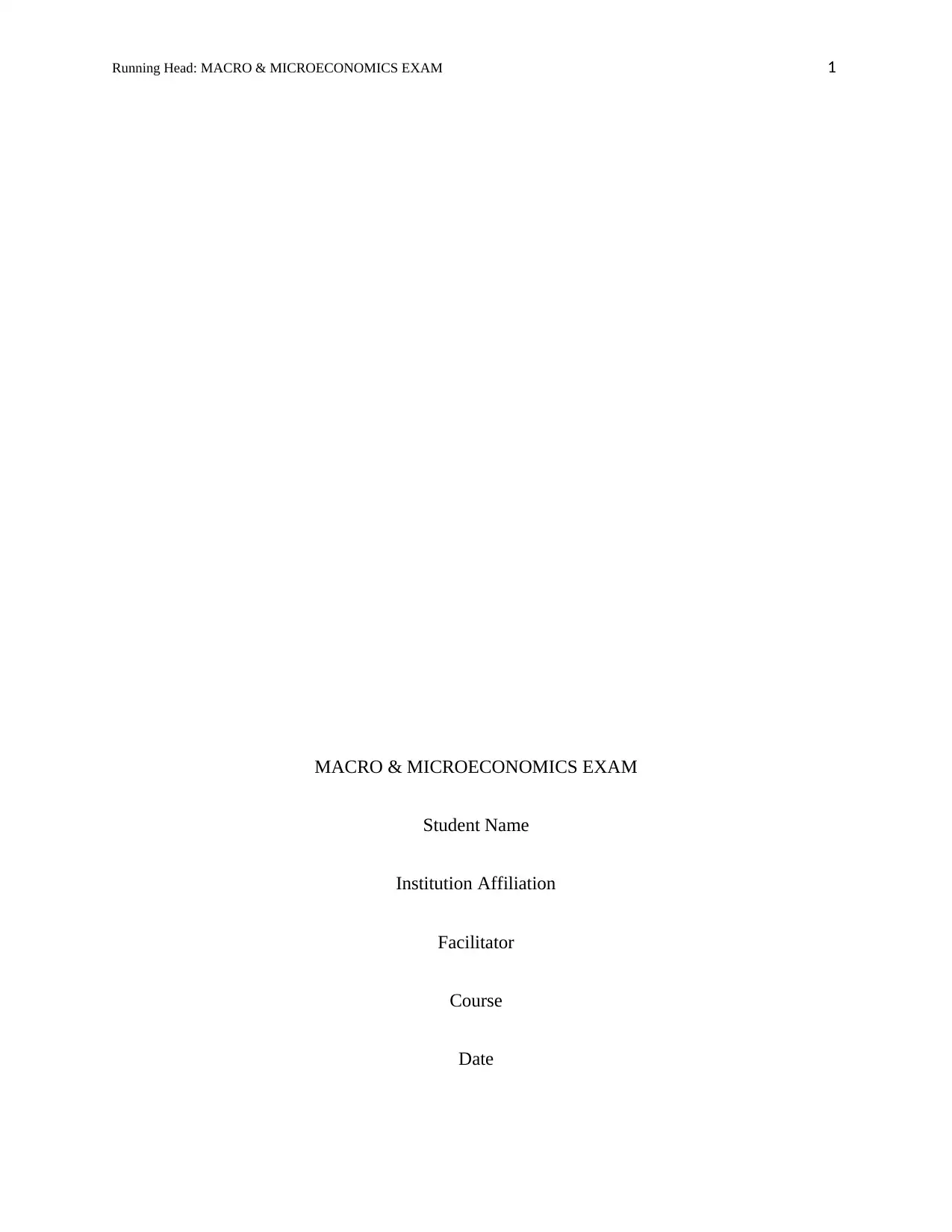
Running Head: MACRO & MICROECONOMICS EXAM 1
MACRO & MICROECONOMICS EXAM
Student Name
Institution Affiliation
Facilitator
Course
Date
MACRO & MICROECONOMICS EXAM
Student Name
Institution Affiliation
Facilitator
Course
Date
Secure Best Marks with AI Grader
Need help grading? Try our AI Grader for instant feedback on your assignments.
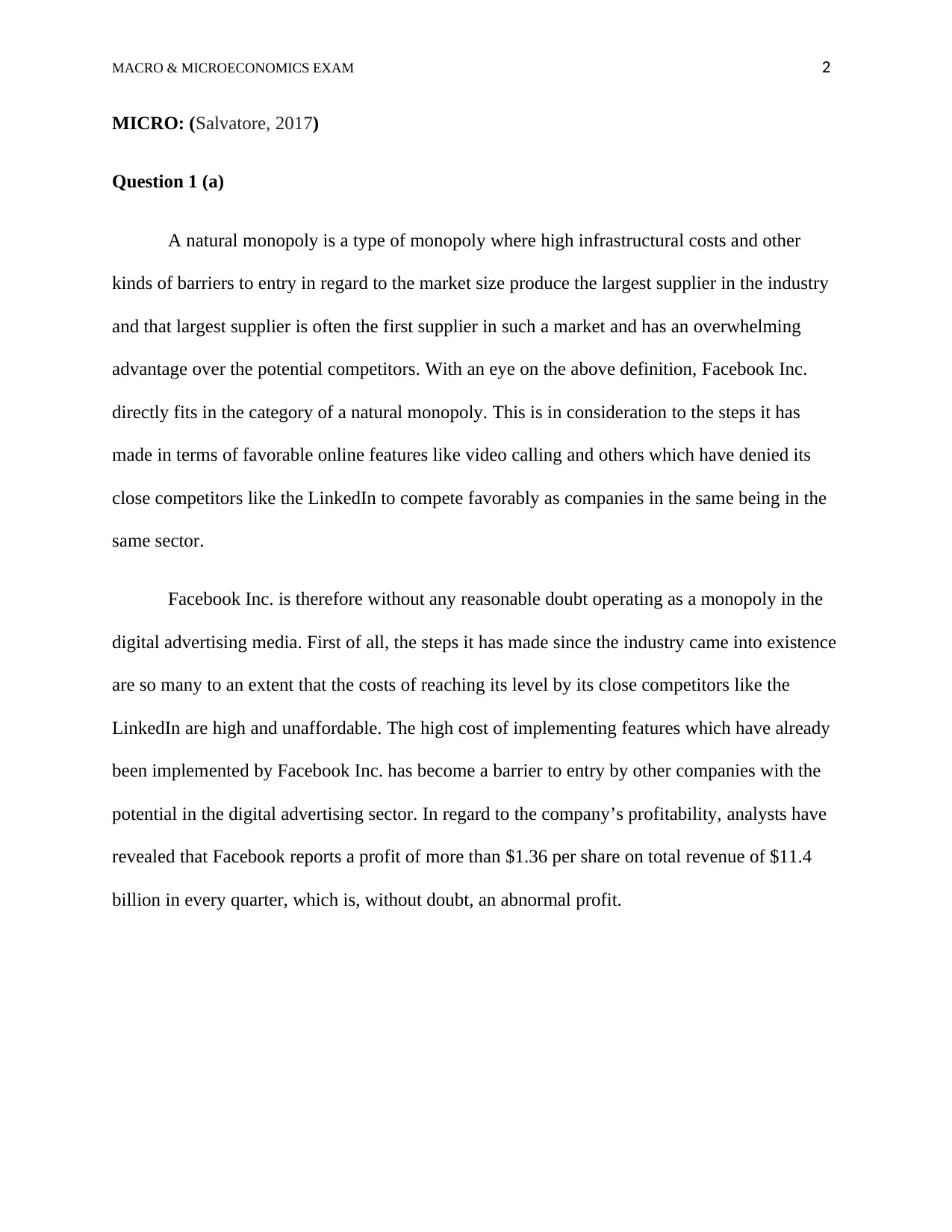
MACRO & MICROECONOMICS EXAM 2
MICRO: (Salvatore, 2017)
Question 1 (a)
A natural monopoly is a type of monopoly where high infrastructural costs and other
kinds of barriers to entry in regard to the market size produce the largest supplier in the industry
and that largest supplier is often the first supplier in such a market and has an overwhelming
advantage over the potential competitors. With an eye on the above definition, Facebook Inc.
directly fits in the category of a natural monopoly. This is in consideration to the steps it has
made in terms of favorable online features like video calling and others which have denied its
close competitors like the LinkedIn to compete favorably as companies in the same being in the
same sector.
Facebook Inc. is therefore without any reasonable doubt operating as a monopoly in the
digital advertising media. First of all, the steps it has made since the industry came into existence
are so many to an extent that the costs of reaching its level by its close competitors like the
LinkedIn are high and unaffordable. The high cost of implementing features which have already
been implemented by Facebook Inc. has become a barrier to entry by other companies with the
potential in the digital advertising sector. In regard to the company’s profitability, analysts have
revealed that Facebook reports a profit of more than $1.36 per share on total revenue of $11.4
billion in every quarter, which is, without doubt, an abnormal profit.
MICRO: (Salvatore, 2017)
Question 1 (a)
A natural monopoly is a type of monopoly where high infrastructural costs and other
kinds of barriers to entry in regard to the market size produce the largest supplier in the industry
and that largest supplier is often the first supplier in such a market and has an overwhelming
advantage over the potential competitors. With an eye on the above definition, Facebook Inc.
directly fits in the category of a natural monopoly. This is in consideration to the steps it has
made in terms of favorable online features like video calling and others which have denied its
close competitors like the LinkedIn to compete favorably as companies in the same being in the
same sector.
Facebook Inc. is therefore without any reasonable doubt operating as a monopoly in the
digital advertising media. First of all, the steps it has made since the industry came into existence
are so many to an extent that the costs of reaching its level by its close competitors like the
LinkedIn are high and unaffordable. The high cost of implementing features which have already
been implemented by Facebook Inc. has become a barrier to entry by other companies with the
potential in the digital advertising sector. In regard to the company’s profitability, analysts have
revealed that Facebook reports a profit of more than $1.36 per share on total revenue of $11.4
billion in every quarter, which is, without doubt, an abnormal profit.
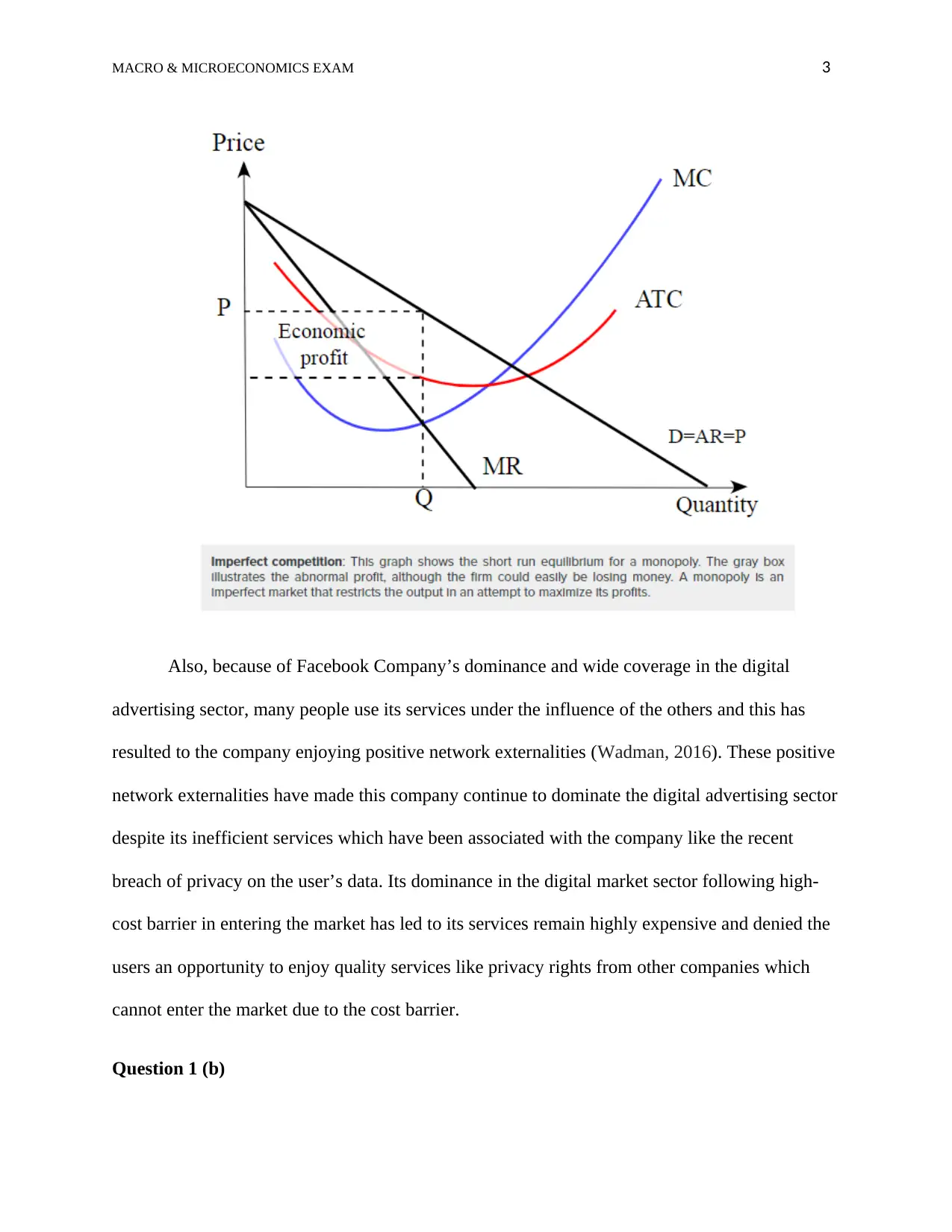
MACRO & MICROECONOMICS EXAM 3
Also, because of Facebook Company’s dominance and wide coverage in the digital
advertising sector, many people use its services under the influence of the others and this has
resulted to the company enjoying positive network externalities (Wadman, 2016). These positive
network externalities have made this company continue to dominate the digital advertising sector
despite its inefficient services which have been associated with the company like the recent
breach of privacy on the user’s data. Its dominance in the digital market sector following high-
cost barrier in entering the market has led to its services remain highly expensive and denied the
users an opportunity to enjoy quality services like privacy rights from other companies which
cannot enter the market due to the cost barrier.
Question 1 (b)
Also, because of Facebook Company’s dominance and wide coverage in the digital
advertising sector, many people use its services under the influence of the others and this has
resulted to the company enjoying positive network externalities (Wadman, 2016). These positive
network externalities have made this company continue to dominate the digital advertising sector
despite its inefficient services which have been associated with the company like the recent
breach of privacy on the user’s data. Its dominance in the digital market sector following high-
cost barrier in entering the market has led to its services remain highly expensive and denied the
users an opportunity to enjoy quality services like privacy rights from other companies which
cannot enter the market due to the cost barrier.
Question 1 (b)
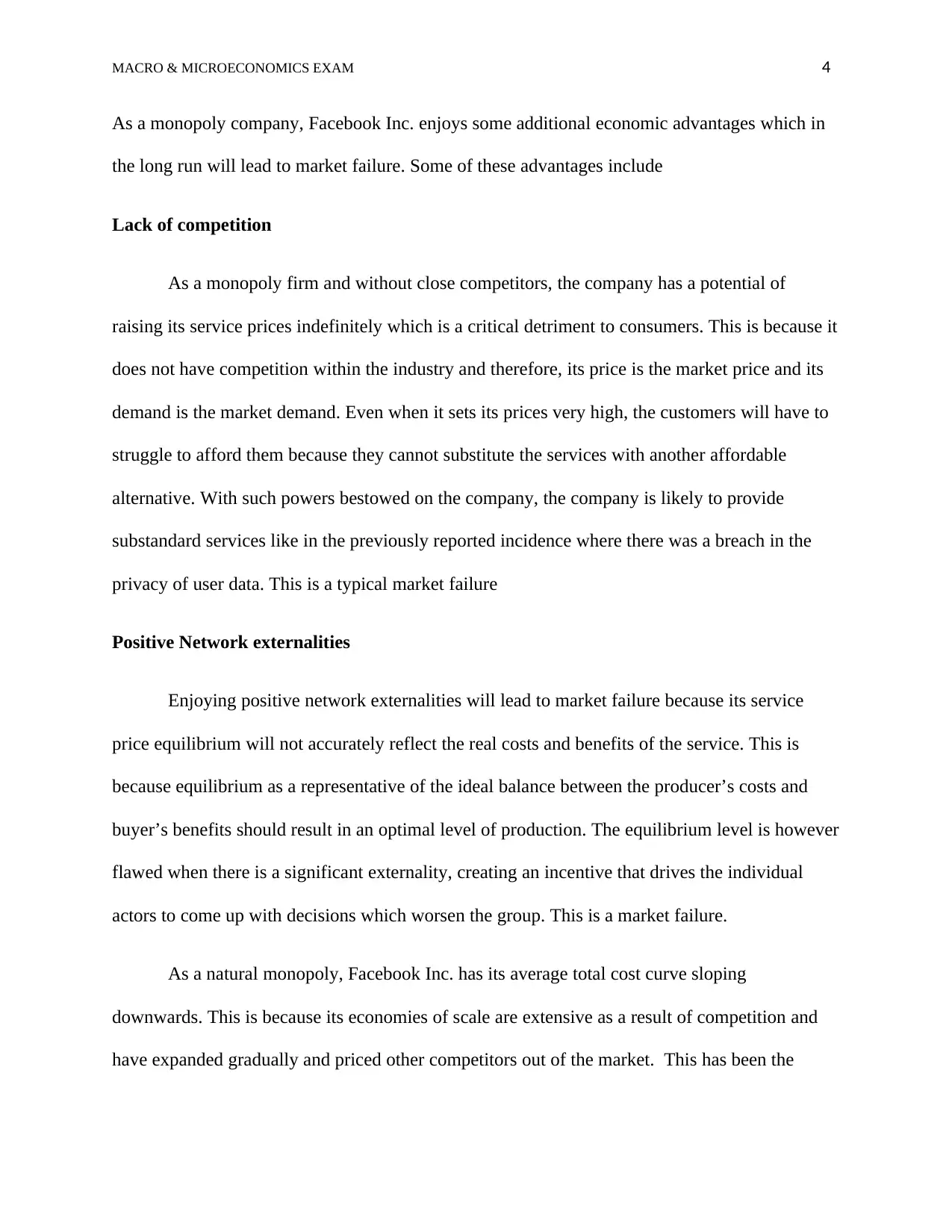
MACRO & MICROECONOMICS EXAM 4
As a monopoly company, Facebook Inc. enjoys some additional economic advantages which in
the long run will lead to market failure. Some of these advantages include
Lack of competition
As a monopoly firm and without close competitors, the company has a potential of
raising its service prices indefinitely which is a critical detriment to consumers. This is because it
does not have competition within the industry and therefore, its price is the market price and its
demand is the market demand. Even when it sets its prices very high, the customers will have to
struggle to afford them because they cannot substitute the services with another affordable
alternative. With such powers bestowed on the company, the company is likely to provide
substandard services like in the previously reported incidence where there was a breach in the
privacy of user data. This is a typical market failure
Positive Network externalities
Enjoying positive network externalities will lead to market failure because its service
price equilibrium will not accurately reflect the real costs and benefits of the service. This is
because equilibrium as a representative of the ideal balance between the producer’s costs and
buyer’s benefits should result in an optimal level of production. The equilibrium level is however
flawed when there is a significant externality, creating an incentive that drives the individual
actors to come up with decisions which worsen the group. This is a market failure.
As a natural monopoly, Facebook Inc. has its average total cost curve sloping
downwards. This is because its economies of scale are extensive as a result of competition and
have expanded gradually and priced other competitors out of the market. This has been the
As a monopoly company, Facebook Inc. enjoys some additional economic advantages which in
the long run will lead to market failure. Some of these advantages include
Lack of competition
As a monopoly firm and without close competitors, the company has a potential of
raising its service prices indefinitely which is a critical detriment to consumers. This is because it
does not have competition within the industry and therefore, its price is the market price and its
demand is the market demand. Even when it sets its prices very high, the customers will have to
struggle to afford them because they cannot substitute the services with another affordable
alternative. With such powers bestowed on the company, the company is likely to provide
substandard services like in the previously reported incidence where there was a breach in the
privacy of user data. This is a typical market failure
Positive Network externalities
Enjoying positive network externalities will lead to market failure because its service
price equilibrium will not accurately reflect the real costs and benefits of the service. This is
because equilibrium as a representative of the ideal balance between the producer’s costs and
buyer’s benefits should result in an optimal level of production. The equilibrium level is however
flawed when there is a significant externality, creating an incentive that drives the individual
actors to come up with decisions which worsen the group. This is a market failure.
As a natural monopoly, Facebook Inc. has its average total cost curve sloping
downwards. This is because its economies of scale are extensive as a result of competition and
have expanded gradually and priced other competitors out of the market. This has been the
Secure Best Marks with AI Grader
Need help grading? Try our AI Grader for instant feedback on your assignments.
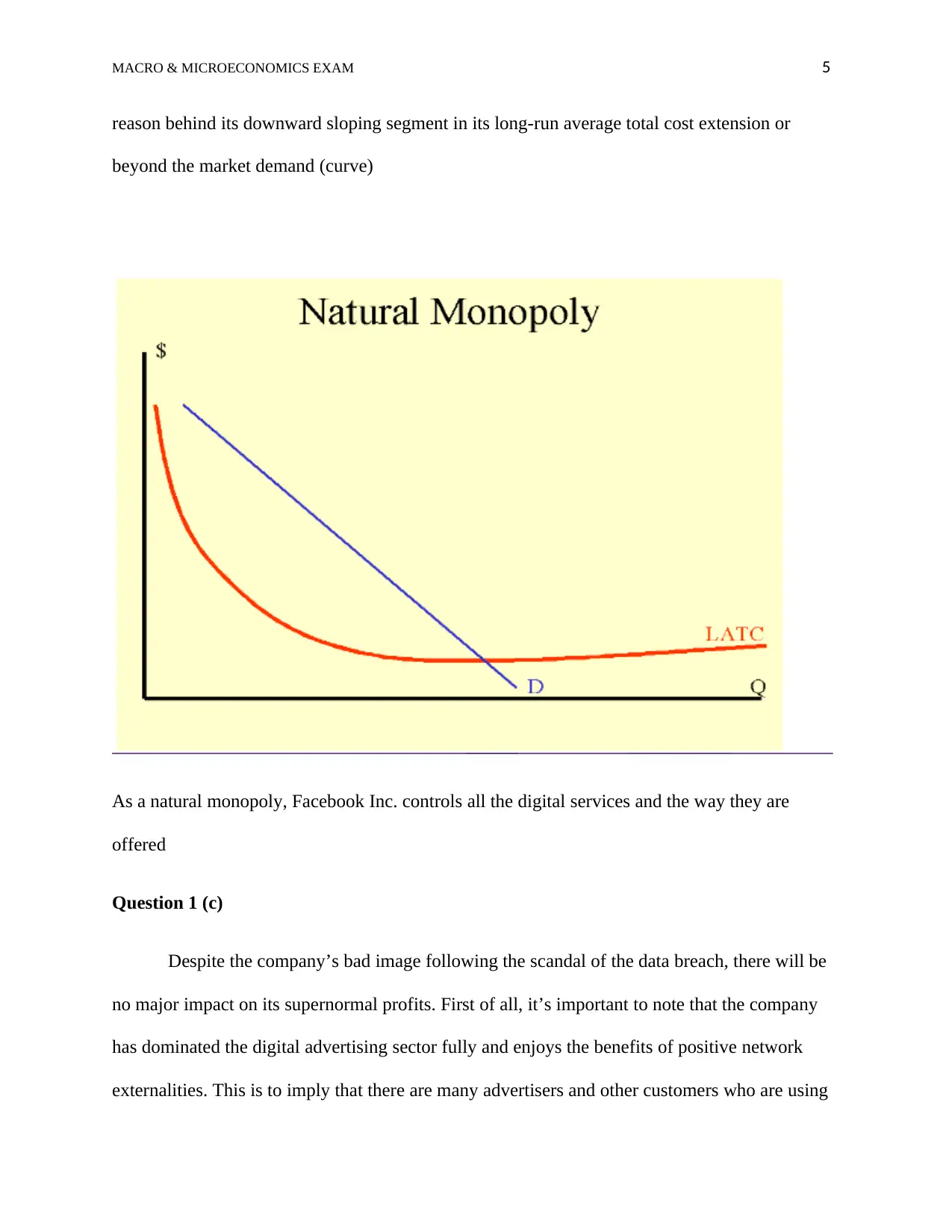
MACRO & MICROECONOMICS EXAM 5
reason behind its downward sloping segment in its long-run average total cost extension or
beyond the market demand (curve)
As a natural monopoly, Facebook Inc. controls all the digital services and the way they are
offered
Question 1 (c)
Despite the company’s bad image following the scandal of the data breach, there will be
no major impact on its supernormal profits. First of all, it’s important to note that the company
has dominated the digital advertising sector fully and enjoys the benefits of positive network
externalities. This is to imply that there are many advertisers and other customers who are using
reason behind its downward sloping segment in its long-run average total cost extension or
beyond the market demand (curve)
As a natural monopoly, Facebook Inc. controls all the digital services and the way they are
offered
Question 1 (c)
Despite the company’s bad image following the scandal of the data breach, there will be
no major impact on its supernormal profits. First of all, it’s important to note that the company
has dominated the digital advertising sector fully and enjoys the benefits of positive network
externalities. This is to imply that there are many advertisers and other customers who are using
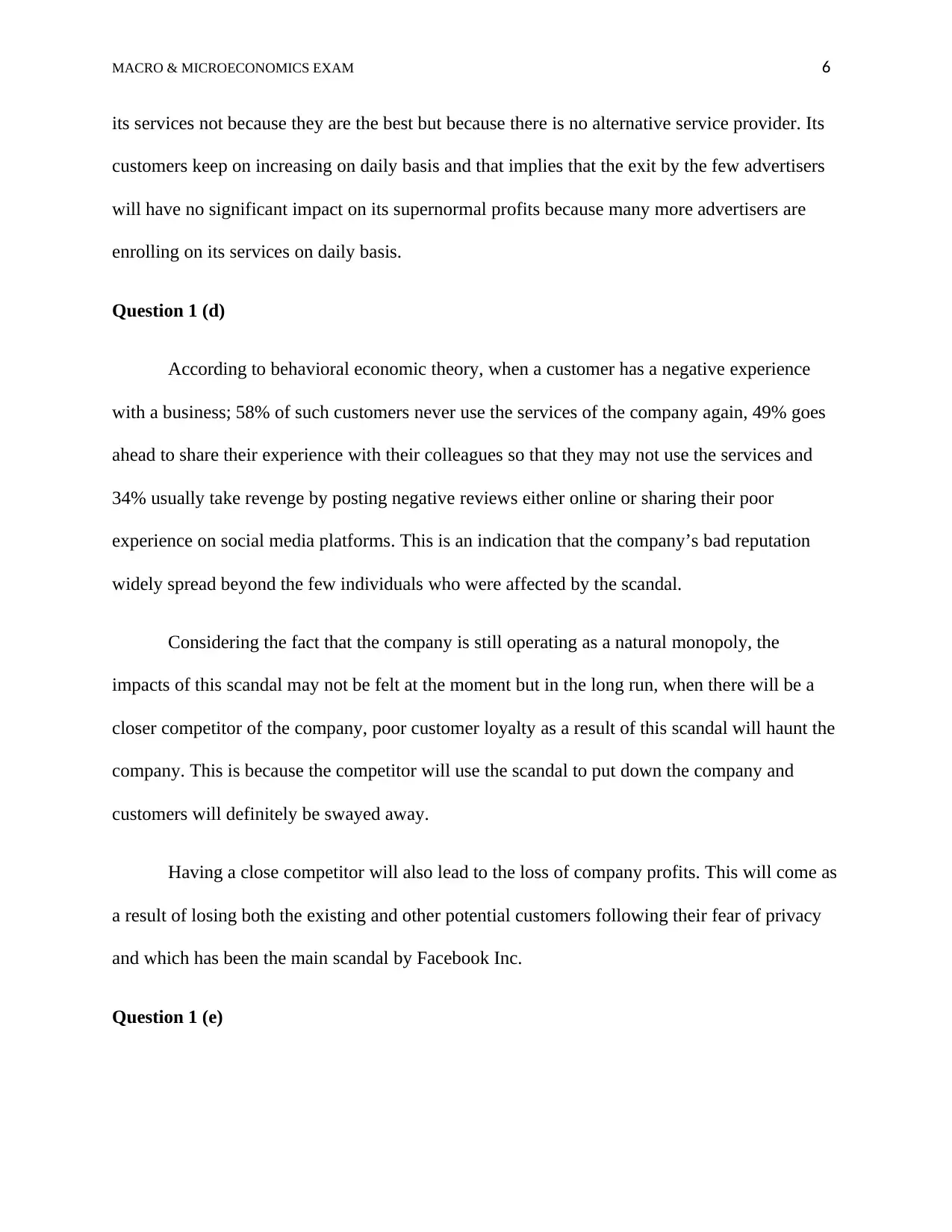
MACRO & MICROECONOMICS EXAM 6
its services not because they are the best but because there is no alternative service provider. Its
customers keep on increasing on daily basis and that implies that the exit by the few advertisers
will have no significant impact on its supernormal profits because many more advertisers are
enrolling on its services on daily basis.
Question 1 (d)
According to behavioral economic theory, when a customer has a negative experience
with a business; 58% of such customers never use the services of the company again, 49% goes
ahead to share their experience with their colleagues so that they may not use the services and
34% usually take revenge by posting negative reviews either online or sharing their poor
experience on social media platforms. This is an indication that the company’s bad reputation
widely spread beyond the few individuals who were affected by the scandal.
Considering the fact that the company is still operating as a natural monopoly, the
impacts of this scandal may not be felt at the moment but in the long run, when there will be a
closer competitor of the company, poor customer loyalty as a result of this scandal will haunt the
company. This is because the competitor will use the scandal to put down the company and
customers will definitely be swayed away.
Having a close competitor will also lead to the loss of company profits. This will come as
a result of losing both the existing and other potential customers following their fear of privacy
and which has been the main scandal by Facebook Inc.
Question 1 (e)
its services not because they are the best but because there is no alternative service provider. Its
customers keep on increasing on daily basis and that implies that the exit by the few advertisers
will have no significant impact on its supernormal profits because many more advertisers are
enrolling on its services on daily basis.
Question 1 (d)
According to behavioral economic theory, when a customer has a negative experience
with a business; 58% of such customers never use the services of the company again, 49% goes
ahead to share their experience with their colleagues so that they may not use the services and
34% usually take revenge by posting negative reviews either online or sharing their poor
experience on social media platforms. This is an indication that the company’s bad reputation
widely spread beyond the few individuals who were affected by the scandal.
Considering the fact that the company is still operating as a natural monopoly, the
impacts of this scandal may not be felt at the moment but in the long run, when there will be a
closer competitor of the company, poor customer loyalty as a result of this scandal will haunt the
company. This is because the competitor will use the scandal to put down the company and
customers will definitely be swayed away.
Having a close competitor will also lead to the loss of company profits. This will come as
a result of losing both the existing and other potential customers following their fear of privacy
and which has been the main scandal by Facebook Inc.
Question 1 (e)
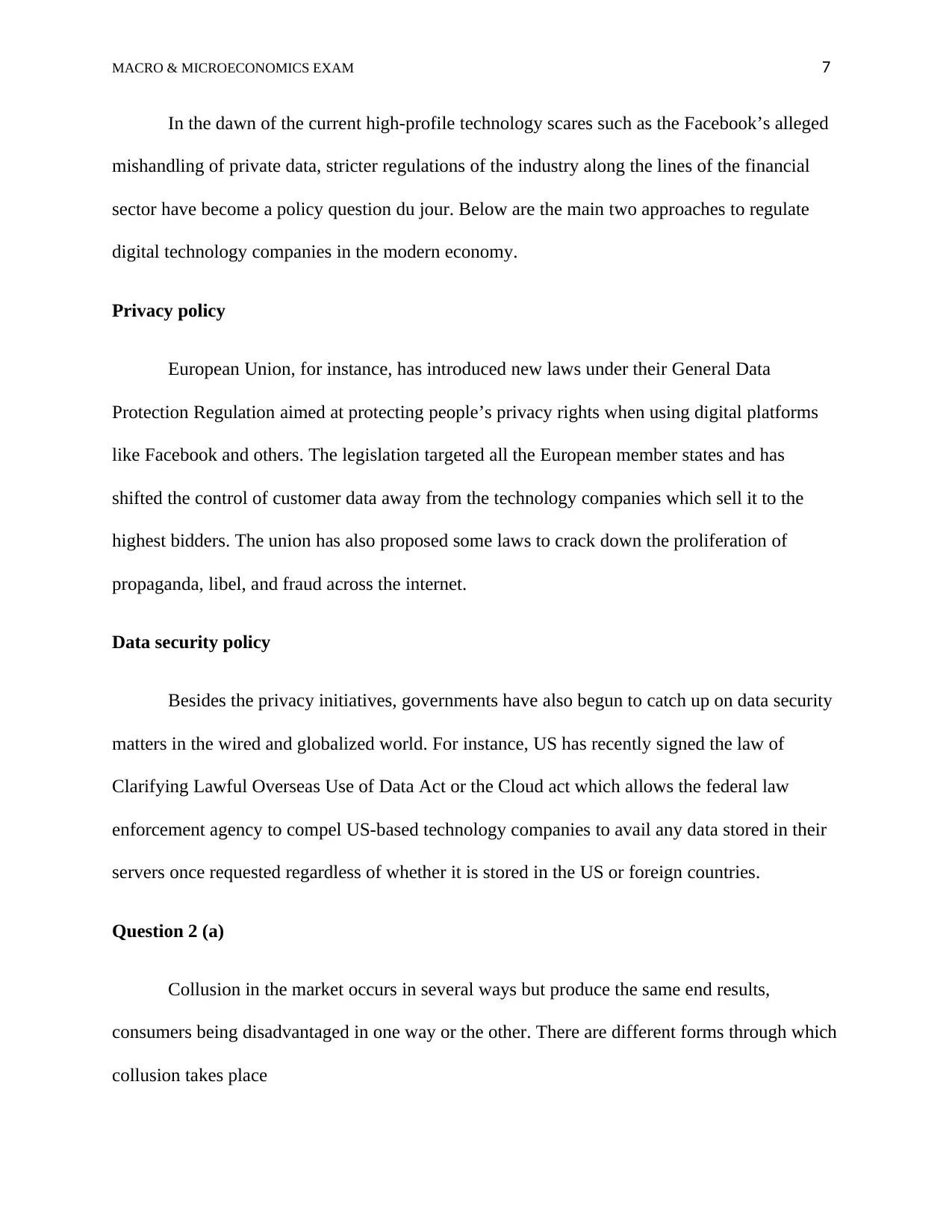
MACRO & MICROECONOMICS EXAM 7
In the dawn of the current high-profile technology scares such as the Facebook’s alleged
mishandling of private data, stricter regulations of the industry along the lines of the financial
sector have become a policy question du jour. Below are the main two approaches to regulate
digital technology companies in the modern economy.
Privacy policy
European Union, for instance, has introduced new laws under their General Data
Protection Regulation aimed at protecting people’s privacy rights when using digital platforms
like Facebook and others. The legislation targeted all the European member states and has
shifted the control of customer data away from the technology companies which sell it to the
highest bidders. The union has also proposed some laws to crack down the proliferation of
propaganda, libel, and fraud across the internet.
Data security policy
Besides the privacy initiatives, governments have also begun to catch up on data security
matters in the wired and globalized world. For instance, US has recently signed the law of
Clarifying Lawful Overseas Use of Data Act or the Cloud act which allows the federal law
enforcement agency to compel US-based technology companies to avail any data stored in their
servers once requested regardless of whether it is stored in the US or foreign countries.
Question 2 (a)
Collusion in the market occurs in several ways but produce the same end results,
consumers being disadvantaged in one way or the other. There are different forms through which
collusion takes place
In the dawn of the current high-profile technology scares such as the Facebook’s alleged
mishandling of private data, stricter regulations of the industry along the lines of the financial
sector have become a policy question du jour. Below are the main two approaches to regulate
digital technology companies in the modern economy.
Privacy policy
European Union, for instance, has introduced new laws under their General Data
Protection Regulation aimed at protecting people’s privacy rights when using digital platforms
like Facebook and others. The legislation targeted all the European member states and has
shifted the control of customer data away from the technology companies which sell it to the
highest bidders. The union has also proposed some laws to crack down the proliferation of
propaganda, libel, and fraud across the internet.
Data security policy
Besides the privacy initiatives, governments have also begun to catch up on data security
matters in the wired and globalized world. For instance, US has recently signed the law of
Clarifying Lawful Overseas Use of Data Act or the Cloud act which allows the federal law
enforcement agency to compel US-based technology companies to avail any data stored in their
servers once requested regardless of whether it is stored in the US or foreign countries.
Question 2 (a)
Collusion in the market occurs in several ways but produce the same end results,
consumers being disadvantaged in one way or the other. There are different forms through which
collusion takes place
Paraphrase This Document
Need a fresh take? Get an instant paraphrase of this document with our AI Paraphraser
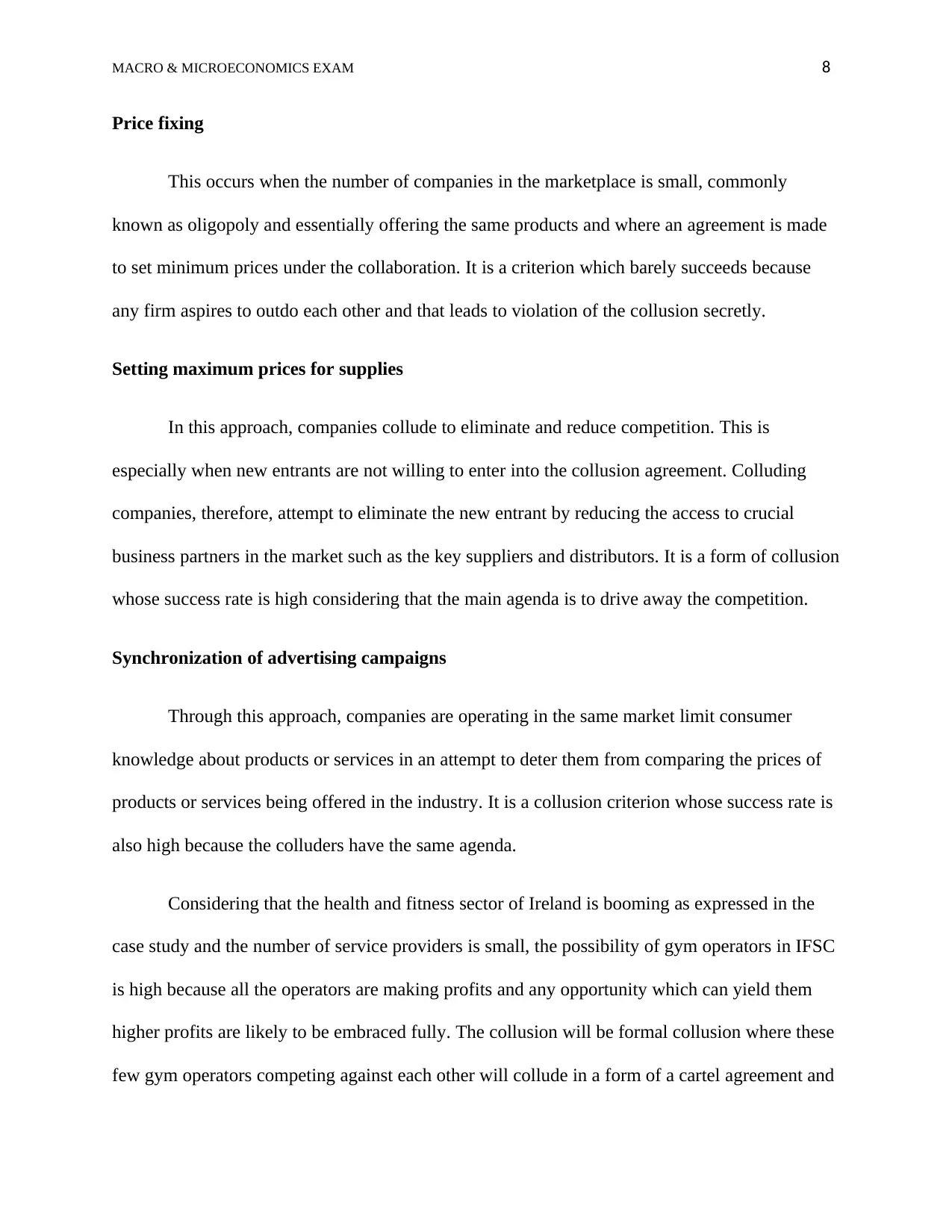
MACRO & MICROECONOMICS EXAM 8
Price fixing
This occurs when the number of companies in the marketplace is small, commonly
known as oligopoly and essentially offering the same products and where an agreement is made
to set minimum prices under the collaboration. It is a criterion which barely succeeds because
any firm aspires to outdo each other and that leads to violation of the collusion secretly.
Setting maximum prices for supplies
In this approach, companies collude to eliminate and reduce competition. This is
especially when new entrants are not willing to enter into the collusion agreement. Colluding
companies, therefore, attempt to eliminate the new entrant by reducing the access to crucial
business partners in the market such as the key suppliers and distributors. It is a form of collusion
whose success rate is high considering that the main agenda is to drive away the competition.
Synchronization of advertising campaigns
Through this approach, companies are operating in the same market limit consumer
knowledge about products or services in an attempt to deter them from comparing the prices of
products or services being offered in the industry. It is a collusion criterion whose success rate is
also high because the colluders have the same agenda.
Considering that the health and fitness sector of Ireland is booming as expressed in the
case study and the number of service providers is small, the possibility of gym operators in IFSC
is high because all the operators are making profits and any opportunity which can yield them
higher profits are likely to be embraced fully. The collusion will be formal collusion where these
few gym operators competing against each other will collude in a form of a cartel agreement and
Price fixing
This occurs when the number of companies in the marketplace is small, commonly
known as oligopoly and essentially offering the same products and where an agreement is made
to set minimum prices under the collaboration. It is a criterion which barely succeeds because
any firm aspires to outdo each other and that leads to violation of the collusion secretly.
Setting maximum prices for supplies
In this approach, companies collude to eliminate and reduce competition. This is
especially when new entrants are not willing to enter into the collusion agreement. Colluding
companies, therefore, attempt to eliminate the new entrant by reducing the access to crucial
business partners in the market such as the key suppliers and distributors. It is a form of collusion
whose success rate is high considering that the main agenda is to drive away the competition.
Synchronization of advertising campaigns
Through this approach, companies are operating in the same market limit consumer
knowledge about products or services in an attempt to deter them from comparing the prices of
products or services being offered in the industry. It is a collusion criterion whose success rate is
also high because the colluders have the same agenda.
Considering that the health and fitness sector of Ireland is booming as expressed in the
case study and the number of service providers is small, the possibility of gym operators in IFSC
is high because all the operators are making profits and any opportunity which can yield them
higher profits are likely to be embraced fully. The collusion will be formal collusion where these
few gym operators competing against each other will collude in a form of a cartel agreement and

MACRO & MICROECONOMICS EXAM 9
set the service prices high for them to yield more profits out of the boom. As a result, they will
all start making supernormal profits as indicated in the figure below.
Question 2 (b)
Price discrimination is a strategy whereby sellers charge different prices to different
consumers for the same product or service. It is a competitive practice largely utilized by the
established businesses in order achieves profitability from differences in supply and demand
from consumers. It takes three common types namely first degree, second degree, and third-
degree price discrimination. First-degree price discrimination takes place when a business
determines what each consumer is willing to pay for a product or a service and then sells it at
set the service prices high for them to yield more profits out of the boom. As a result, they will
all start making supernormal profits as indicated in the figure below.
Question 2 (b)
Price discrimination is a strategy whereby sellers charge different prices to different
consumers for the same product or service. It is a competitive practice largely utilized by the
established businesses in order achieves profitability from differences in supply and demand
from consumers. It takes three common types namely first degree, second degree, and third-
degree price discrimination. First-degree price discrimination takes place when a business
determines what each consumer is willing to pay for a product or a service and then sells it at
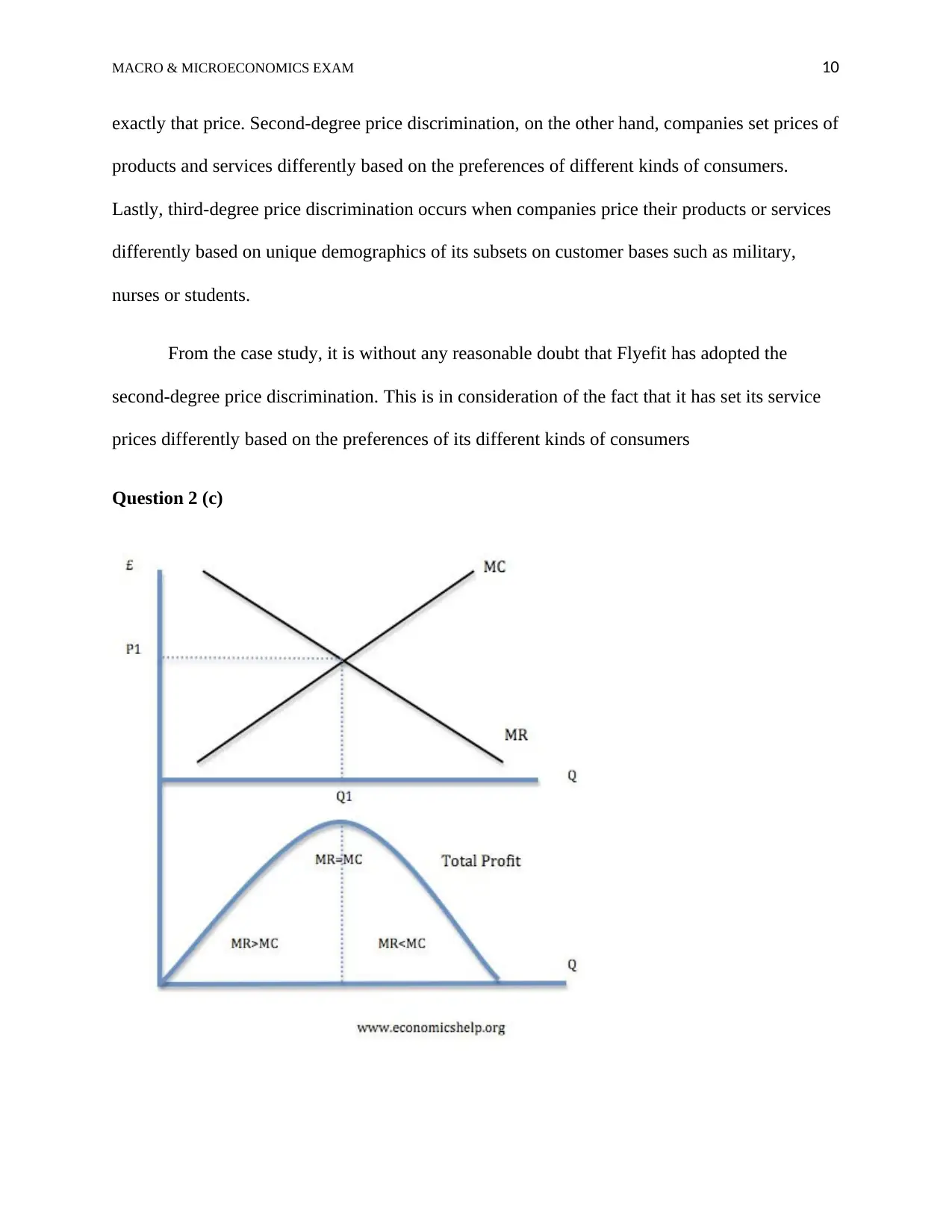
MACRO & MICROECONOMICS EXAM 10
exactly that price. Second-degree price discrimination, on the other hand, companies set prices of
products and services differently based on the preferences of different kinds of consumers.
Lastly, third-degree price discrimination occurs when companies price their products or services
differently based on unique demographics of its subsets on customer bases such as military,
nurses or students.
From the case study, it is without any reasonable doubt that Flyefit has adopted the
second-degree price discrimination. This is in consideration of the fact that it has set its service
prices differently based on the preferences of its different kinds of consumers
Question 2 (c)
exactly that price. Second-degree price discrimination, on the other hand, companies set prices of
products and services differently based on the preferences of different kinds of consumers.
Lastly, third-degree price discrimination occurs when companies price their products or services
differently based on unique demographics of its subsets on customer bases such as military,
nurses or students.
From the case study, it is without any reasonable doubt that Flyefit has adopted the
second-degree price discrimination. This is in consideration of the fact that it has set its service
prices differently based on the preferences of its different kinds of consumers
Question 2 (c)
Secure Best Marks with AI Grader
Need help grading? Try our AI Grader for instant feedback on your assignments.
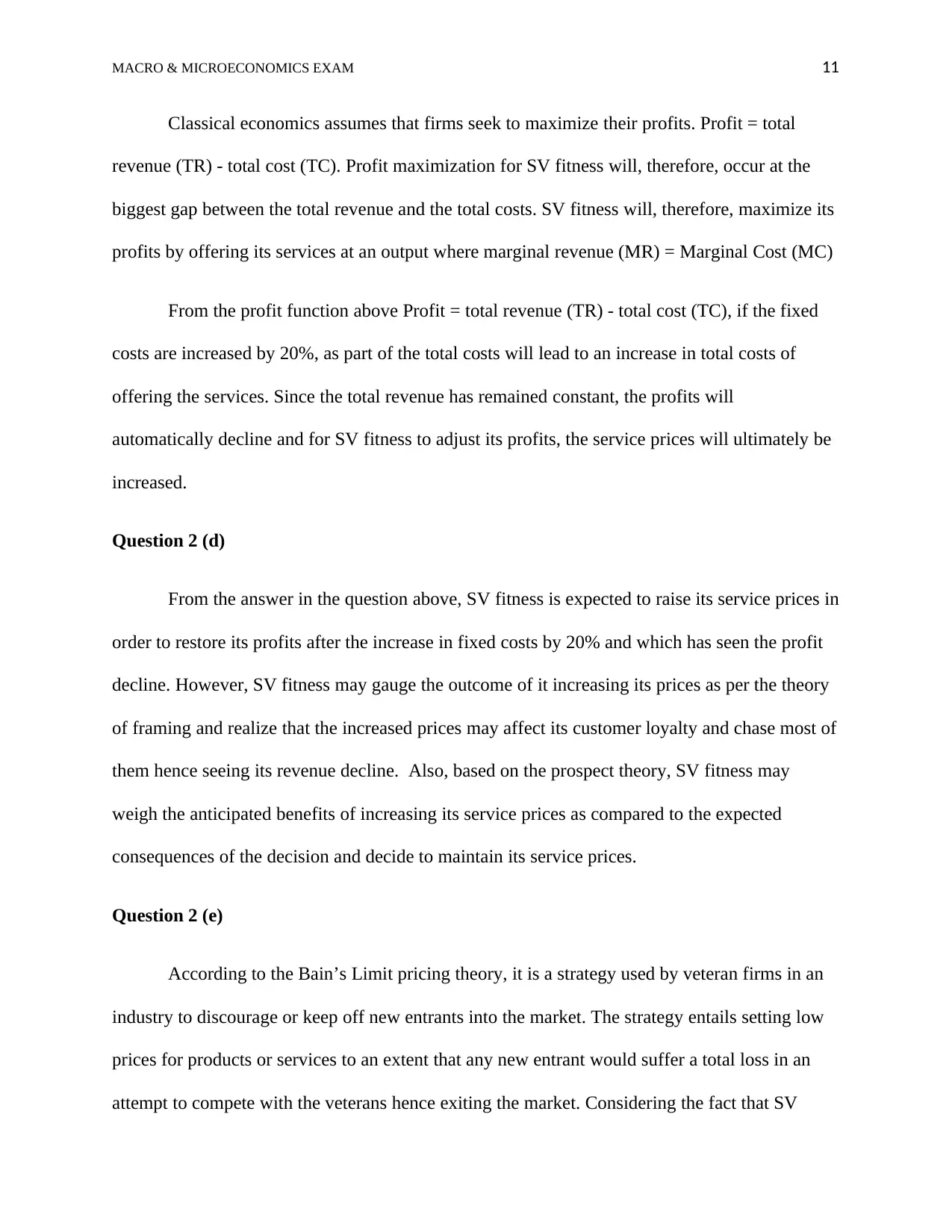
MACRO & MICROECONOMICS EXAM 11
Classical economics assumes that firms seek to maximize their profits. Profit = total
revenue (TR) - total cost (TC). Profit maximization for SV fitness will, therefore, occur at the
biggest gap between the total revenue and the total costs. SV fitness will, therefore, maximize its
profits by offering its services at an output where marginal revenue (MR) = Marginal Cost (MC)
From the profit function above Profit = total revenue (TR) - total cost (TC), if the fixed
costs are increased by 20%, as part of the total costs will lead to an increase in total costs of
offering the services. Since the total revenue has remained constant, the profits will
automatically decline and for SV fitness to adjust its profits, the service prices will ultimately be
increased.
Question 2 (d)
From the answer in the question above, SV fitness is expected to raise its service prices in
order to restore its profits after the increase in fixed costs by 20% and which has seen the profit
decline. However, SV fitness may gauge the outcome of it increasing its prices as per the theory
of framing and realize that the increased prices may affect its customer loyalty and chase most of
them hence seeing its revenue decline. Also, based on the prospect theory, SV fitness may
weigh the anticipated benefits of increasing its service prices as compared to the expected
consequences of the decision and decide to maintain its service prices.
Question 2 (e)
According to the Bain’s Limit pricing theory, it is a strategy used by veteran firms in an
industry to discourage or keep off new entrants into the market. The strategy entails setting low
prices for products or services to an extent that any new entrant would suffer a total loss in an
attempt to compete with the veterans hence exiting the market. Considering the fact that SV
Classical economics assumes that firms seek to maximize their profits. Profit = total
revenue (TR) - total cost (TC). Profit maximization for SV fitness will, therefore, occur at the
biggest gap between the total revenue and the total costs. SV fitness will, therefore, maximize its
profits by offering its services at an output where marginal revenue (MR) = Marginal Cost (MC)
From the profit function above Profit = total revenue (TR) - total cost (TC), if the fixed
costs are increased by 20%, as part of the total costs will lead to an increase in total costs of
offering the services. Since the total revenue has remained constant, the profits will
automatically decline and for SV fitness to adjust its profits, the service prices will ultimately be
increased.
Question 2 (d)
From the answer in the question above, SV fitness is expected to raise its service prices in
order to restore its profits after the increase in fixed costs by 20% and which has seen the profit
decline. However, SV fitness may gauge the outcome of it increasing its prices as per the theory
of framing and realize that the increased prices may affect its customer loyalty and chase most of
them hence seeing its revenue decline. Also, based on the prospect theory, SV fitness may
weigh the anticipated benefits of increasing its service prices as compared to the expected
consequences of the decision and decide to maintain its service prices.
Question 2 (e)
According to the Bain’s Limit pricing theory, it is a strategy used by veteran firms in an
industry to discourage or keep off new entrants into the market. The strategy entails setting low
prices for products or services to an extent that any new entrant would suffer a total loss in an
attempt to compete with the veterans hence exiting the market. Considering the fact that SV
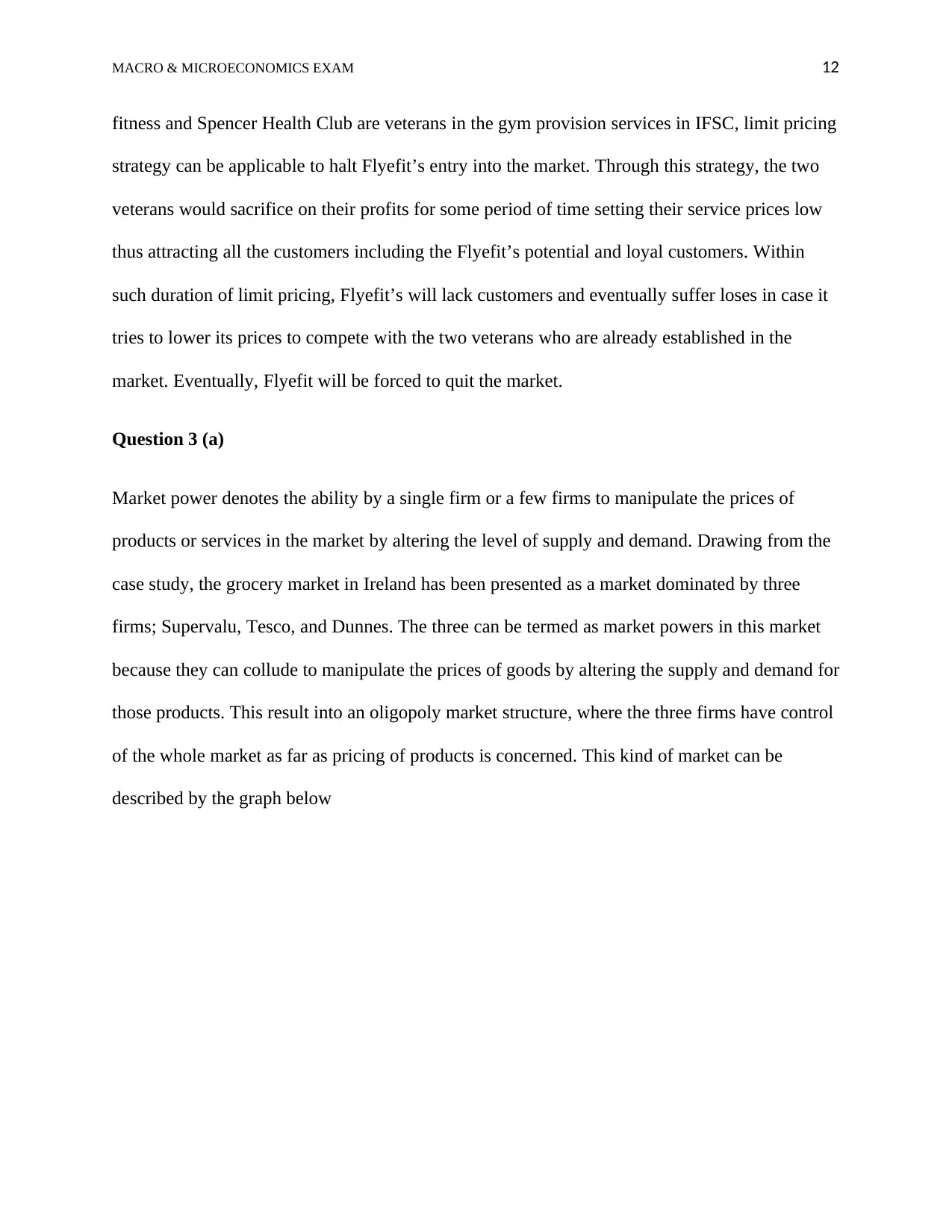
MACRO & MICROECONOMICS EXAM 12
fitness and Spencer Health Club are veterans in the gym provision services in IFSC, limit pricing
strategy can be applicable to halt Flyefit’s entry into the market. Through this strategy, the two
veterans would sacrifice on their profits for some period of time setting their service prices low
thus attracting all the customers including the Flyefit’s potential and loyal customers. Within
such duration of limit pricing, Flyefit’s will lack customers and eventually suffer loses in case it
tries to lower its prices to compete with the two veterans who are already established in the
market. Eventually, Flyefit will be forced to quit the market.
Question 3 (a)
Market power denotes the ability by a single firm or a few firms to manipulate the prices of
products or services in the market by altering the level of supply and demand. Drawing from the
case study, the grocery market in Ireland has been presented as a market dominated by three
firms; Supervalu, Tesco, and Dunnes. The three can be termed as market powers in this market
because they can collude to manipulate the prices of goods by altering the supply and demand for
those products. This result into an oligopoly market structure, where the three firms have control
of the whole market as far as pricing of products is concerned. This kind of market can be
described by the graph below
fitness and Spencer Health Club are veterans in the gym provision services in IFSC, limit pricing
strategy can be applicable to halt Flyefit’s entry into the market. Through this strategy, the two
veterans would sacrifice on their profits for some period of time setting their service prices low
thus attracting all the customers including the Flyefit’s potential and loyal customers. Within
such duration of limit pricing, Flyefit’s will lack customers and eventually suffer loses in case it
tries to lower its prices to compete with the two veterans who are already established in the
market. Eventually, Flyefit will be forced to quit the market.
Question 3 (a)
Market power denotes the ability by a single firm or a few firms to manipulate the prices of
products or services in the market by altering the level of supply and demand. Drawing from the
case study, the grocery market in Ireland has been presented as a market dominated by three
firms; Supervalu, Tesco, and Dunnes. The three can be termed as market powers in this market
because they can collude to manipulate the prices of goods by altering the supply and demand for
those products. This result into an oligopoly market structure, where the three firms have control
of the whole market as far as pricing of products is concerned. This kind of market can be
described by the graph below

MACRO & MICROECONOMICS EXAM 13
Question 3 (b)
An economy of scale denotes the reduced cost per unit that is realized from an increased total
output of a product. For instance, the three veteran supermarkets in the Irelands grocery market,
Supervalu, Tesco, and Dunnes have the ability to acquire products from domestic producers or
import in bulk that enables them to get discounts and other incentives. Also, acquisition of
products in bulk reduces the average total costs of products which enables them still enjoy profits
even when selling their products at low prices.
This concept can be summarized as in the graph below
Question 3 (b)
An economy of scale denotes the reduced cost per unit that is realized from an increased total
output of a product. For instance, the three veteran supermarkets in the Irelands grocery market,
Supervalu, Tesco, and Dunnes have the ability to acquire products from domestic producers or
import in bulk that enables them to get discounts and other incentives. Also, acquisition of
products in bulk reduces the average total costs of products which enables them still enjoy profits
even when selling their products at low prices.
This concept can be summarized as in the graph below
Paraphrase This Document
Need a fresh take? Get an instant paraphrase of this document with our AI Paraphraser
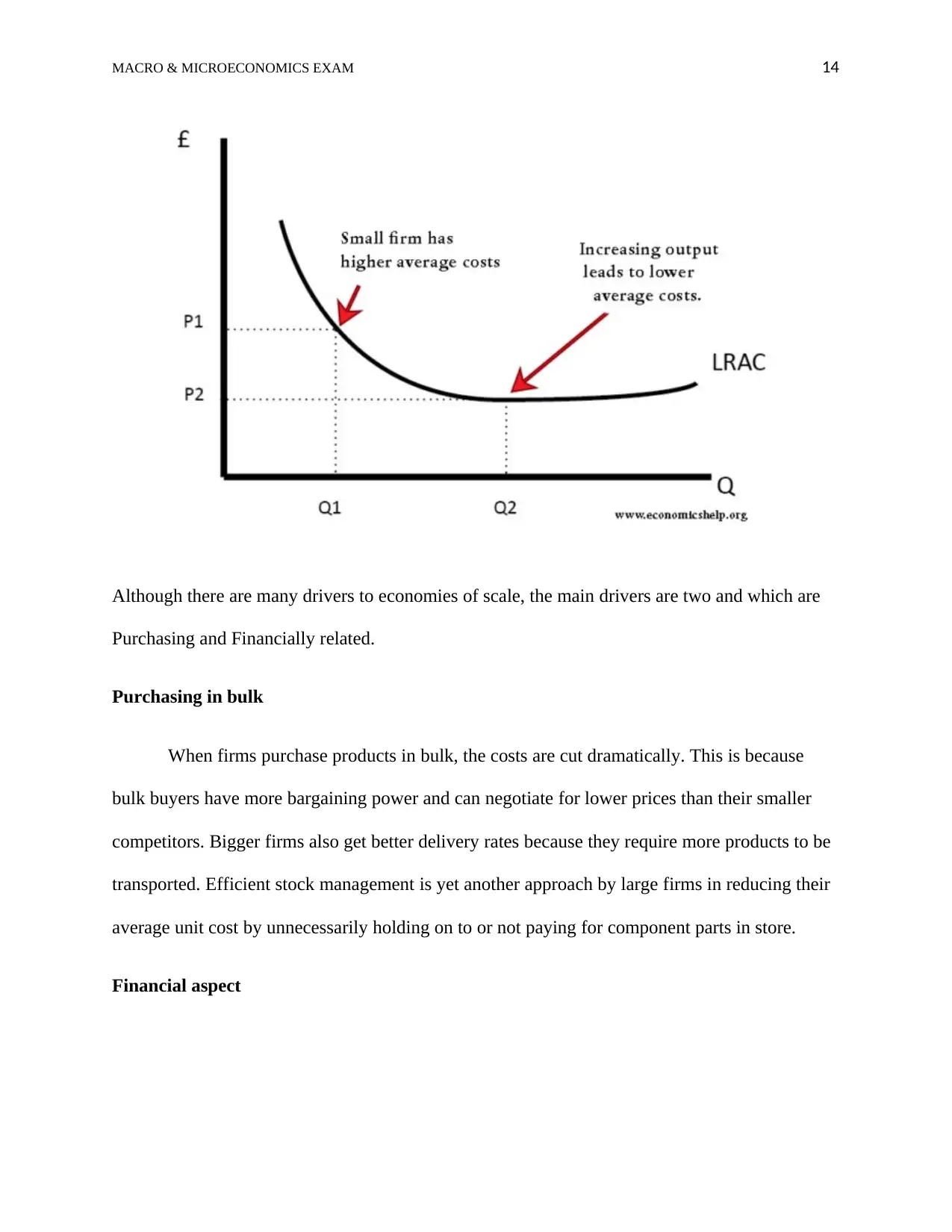
MACRO & MICROECONOMICS EXAM 14
Although there are many drivers to economies of scale, the main drivers are two and which are
Purchasing and Financially related.
Purchasing in bulk
When firms purchase products in bulk, the costs are cut dramatically. This is because
bulk buyers have more bargaining power and can negotiate for lower prices than their smaller
competitors. Bigger firms also get better delivery rates because they require more products to be
transported. Efficient stock management is yet another approach by large firms in reducing their
average unit cost by unnecessarily holding on to or not paying for component parts in store.
Financial aspect
Although there are many drivers to economies of scale, the main drivers are two and which are
Purchasing and Financially related.
Purchasing in bulk
When firms purchase products in bulk, the costs are cut dramatically. This is because
bulk buyers have more bargaining power and can negotiate for lower prices than their smaller
competitors. Bigger firms also get better delivery rates because they require more products to be
transported. Efficient stock management is yet another approach by large firms in reducing their
average unit cost by unnecessarily holding on to or not paying for component parts in store.
Financial aspect
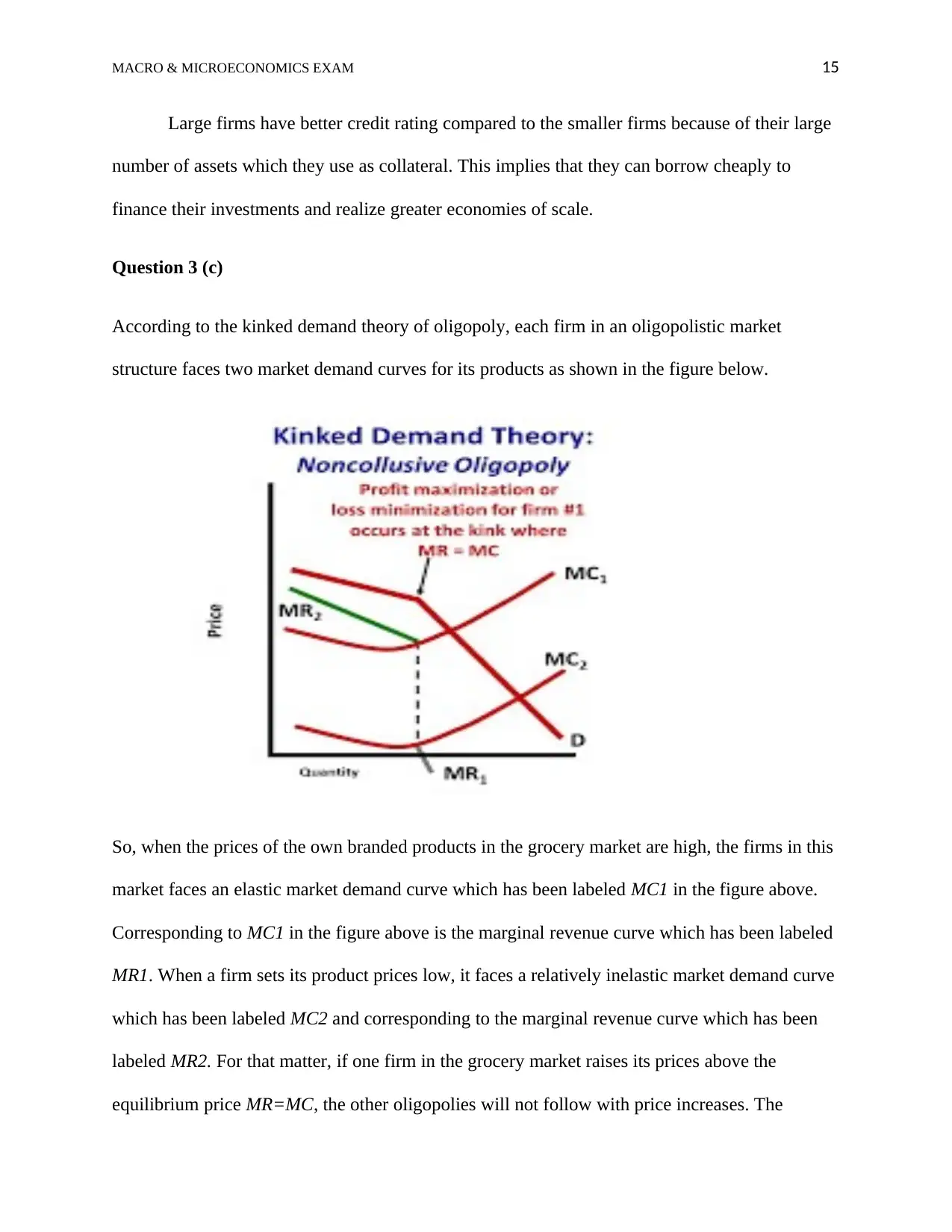
MACRO & MICROECONOMICS EXAM 15
Large firms have better credit rating compared to the smaller firms because of their large
number of assets which they use as collateral. This implies that they can borrow cheaply to
finance their investments and realize greater economies of scale.
Question 3 (c)
According to the kinked demand theory of oligopoly, each firm in an oligopolistic market
structure faces two market demand curves for its products as shown in the figure below.
So, when the prices of the own branded products in the grocery market are high, the firms in this
market faces an elastic market demand curve which has been labeled MC1 in the figure above.
Corresponding to MC1 in the figure above is the marginal revenue curve which has been labeled
MR1. When a firm sets its product prices low, it faces a relatively inelastic market demand curve
which has been labeled MC2 and corresponding to the marginal revenue curve which has been
labeled MR2. For that matter, if one firm in the grocery market raises its prices above the
equilibrium price MR=MC, the other oligopolies will not follow with price increases. The
Large firms have better credit rating compared to the smaller firms because of their large
number of assets which they use as collateral. This implies that they can borrow cheaply to
finance their investments and realize greater economies of scale.
Question 3 (c)
According to the kinked demand theory of oligopoly, each firm in an oligopolistic market
structure faces two market demand curves for its products as shown in the figure below.
So, when the prices of the own branded products in the grocery market are high, the firms in this
market faces an elastic market demand curve which has been labeled MC1 in the figure above.
Corresponding to MC1 in the figure above is the marginal revenue curve which has been labeled
MR1. When a firm sets its product prices low, it faces a relatively inelastic market demand curve
which has been labeled MC2 and corresponding to the marginal revenue curve which has been
labeled MR2. For that matter, if one firm in the grocery market raises its prices above the
equilibrium price MR=MC, the other oligopolies will not follow with price increases. The
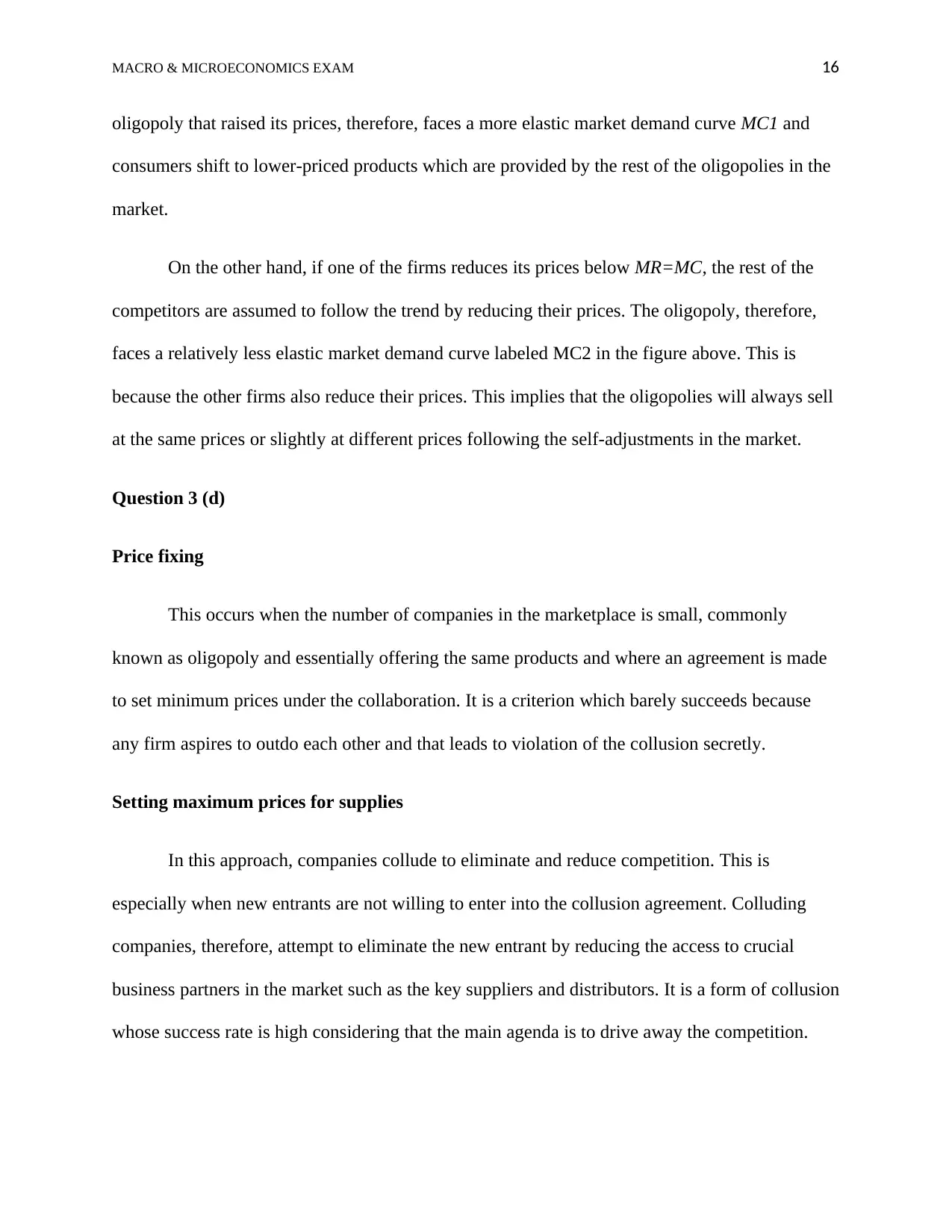
MACRO & MICROECONOMICS EXAM 16
oligopoly that raised its prices, therefore, faces a more elastic market demand curve MC1 and
consumers shift to lower-priced products which are provided by the rest of the oligopolies in the
market.
On the other hand, if one of the firms reduces its prices below MR=MC, the rest of the
competitors are assumed to follow the trend by reducing their prices. The oligopoly, therefore,
faces a relatively less elastic market demand curve labeled MC2 in the figure above. This is
because the other firms also reduce their prices. This implies that the oligopolies will always sell
at the same prices or slightly at different prices following the self-adjustments in the market.
Question 3 (d)
Price fixing
This occurs when the number of companies in the marketplace is small, commonly
known as oligopoly and essentially offering the same products and where an agreement is made
to set minimum prices under the collaboration. It is a criterion which barely succeeds because
any firm aspires to outdo each other and that leads to violation of the collusion secretly.
Setting maximum prices for supplies
In this approach, companies collude to eliminate and reduce competition. This is
especially when new entrants are not willing to enter into the collusion agreement. Colluding
companies, therefore, attempt to eliminate the new entrant by reducing the access to crucial
business partners in the market such as the key suppliers and distributors. It is a form of collusion
whose success rate is high considering that the main agenda is to drive away the competition.
oligopoly that raised its prices, therefore, faces a more elastic market demand curve MC1 and
consumers shift to lower-priced products which are provided by the rest of the oligopolies in the
market.
On the other hand, if one of the firms reduces its prices below MR=MC, the rest of the
competitors are assumed to follow the trend by reducing their prices. The oligopoly, therefore,
faces a relatively less elastic market demand curve labeled MC2 in the figure above. This is
because the other firms also reduce their prices. This implies that the oligopolies will always sell
at the same prices or slightly at different prices following the self-adjustments in the market.
Question 3 (d)
Price fixing
This occurs when the number of companies in the marketplace is small, commonly
known as oligopoly and essentially offering the same products and where an agreement is made
to set minimum prices under the collaboration. It is a criterion which barely succeeds because
any firm aspires to outdo each other and that leads to violation of the collusion secretly.
Setting maximum prices for supplies
In this approach, companies collude to eliminate and reduce competition. This is
especially when new entrants are not willing to enter into the collusion agreement. Colluding
companies, therefore, attempt to eliminate the new entrant by reducing the access to crucial
business partners in the market such as the key suppliers and distributors. It is a form of collusion
whose success rate is high considering that the main agenda is to drive away the competition.
Secure Best Marks with AI Grader
Need help grading? Try our AI Grader for instant feedback on your assignments.
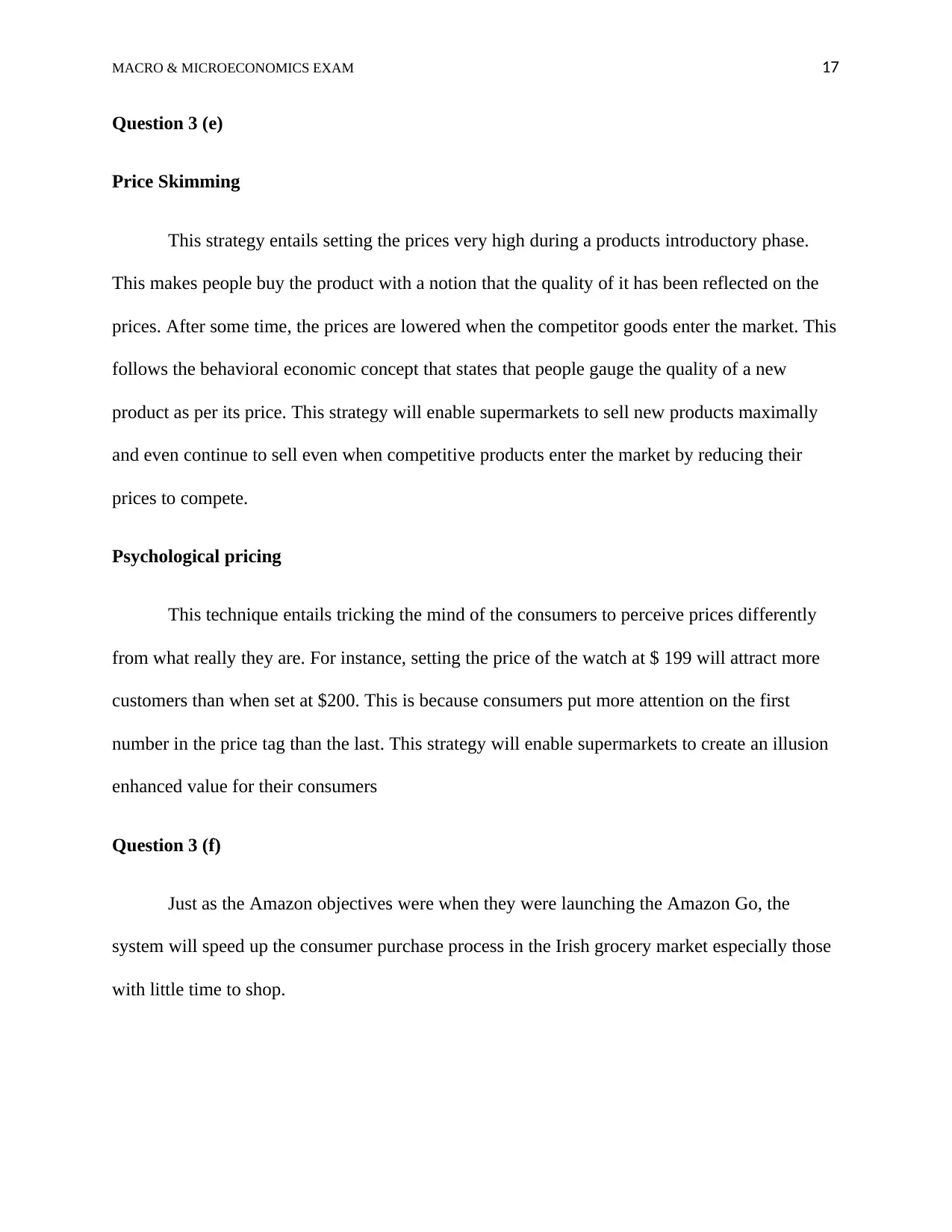
MACRO & MICROECONOMICS EXAM 17
Question 3 (e)
Price Skimming
This strategy entails setting the prices very high during a products introductory phase.
This makes people buy the product with a notion that the quality of it has been reflected on the
prices. After some time, the prices are lowered when the competitor goods enter the market. This
follows the behavioral economic concept that states that people gauge the quality of a new
product as per its price. This strategy will enable supermarkets to sell new products maximally
and even continue to sell even when competitive products enter the market by reducing their
prices to compete.
Psychological pricing
This technique entails tricking the mind of the consumers to perceive prices differently
from what really they are. For instance, setting the price of the watch at $ 199 will attract more
customers than when set at $200. This is because consumers put more attention on the first
number in the price tag than the last. This strategy will enable supermarkets to create an illusion
enhanced value for their consumers
Question 3 (f)
Just as the Amazon objectives were when they were launching the Amazon Go, the
system will speed up the consumer purchase process in the Irish grocery market especially those
with little time to shop.
Question 3 (e)
Price Skimming
This strategy entails setting the prices very high during a products introductory phase.
This makes people buy the product with a notion that the quality of it has been reflected on the
prices. After some time, the prices are lowered when the competitor goods enter the market. This
follows the behavioral economic concept that states that people gauge the quality of a new
product as per its price. This strategy will enable supermarkets to sell new products maximally
and even continue to sell even when competitive products enter the market by reducing their
prices to compete.
Psychological pricing
This technique entails tricking the mind of the consumers to perceive prices differently
from what really they are. For instance, setting the price of the watch at $ 199 will attract more
customers than when set at $200. This is because consumers put more attention on the first
number in the price tag than the last. This strategy will enable supermarkets to create an illusion
enhanced value for their consumers
Question 3 (f)
Just as the Amazon objectives were when they were launching the Amazon Go, the
system will speed up the consumer purchase process in the Irish grocery market especially those
with little time to shop.
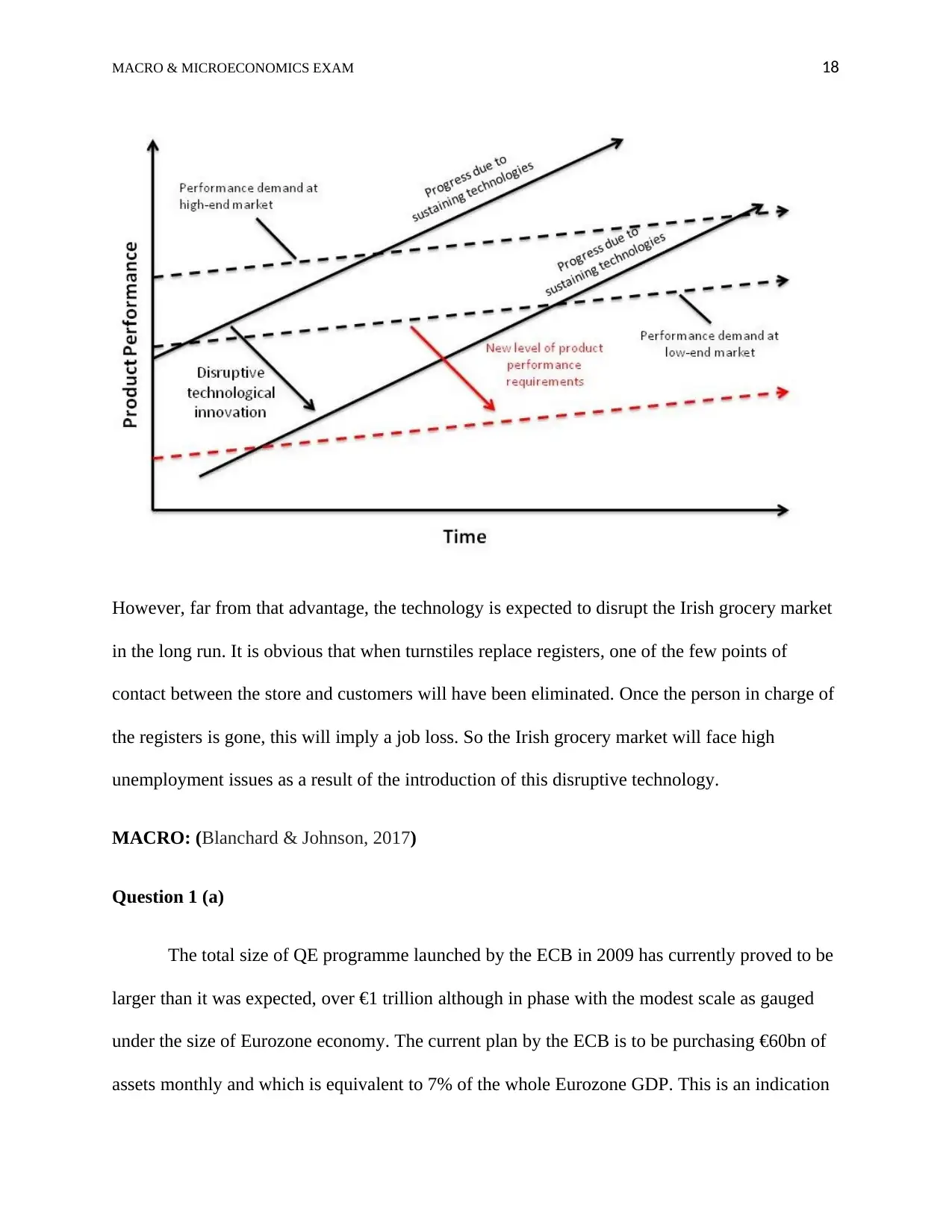
MACRO & MICROECONOMICS EXAM 18
However, far from that advantage, the technology is expected to disrupt the Irish grocery market
in the long run. It is obvious that when turnstiles replace registers, one of the few points of
contact between the store and customers will have been eliminated. Once the person in charge of
the registers is gone, this will imply a job loss. So the Irish grocery market will face high
unemployment issues as a result of the introduction of this disruptive technology.
MACRO: (Blanchard & Johnson, 2017)
Question 1 (a)
The total size of QE programme launched by the ECB in 2009 has currently proved to be
larger than it was expected, over €1 trillion although in phase with the modest scale as gauged
under the size of Eurozone economy. The current plan by the ECB is to be purchasing €60bn of
assets monthly and which is equivalent to 7% of the whole Eurozone GDP. This is an indication
However, far from that advantage, the technology is expected to disrupt the Irish grocery market
in the long run. It is obvious that when turnstiles replace registers, one of the few points of
contact between the store and customers will have been eliminated. Once the person in charge of
the registers is gone, this will imply a job loss. So the Irish grocery market will face high
unemployment issues as a result of the introduction of this disruptive technology.
MACRO: (Blanchard & Johnson, 2017)
Question 1 (a)
The total size of QE programme launched by the ECB in 2009 has currently proved to be
larger than it was expected, over €1 trillion although in phase with the modest scale as gauged
under the size of Eurozone economy. The current plan by the ECB is to be purchasing €60bn of
assets monthly and which is equivalent to 7% of the whole Eurozone GDP. This is an indication
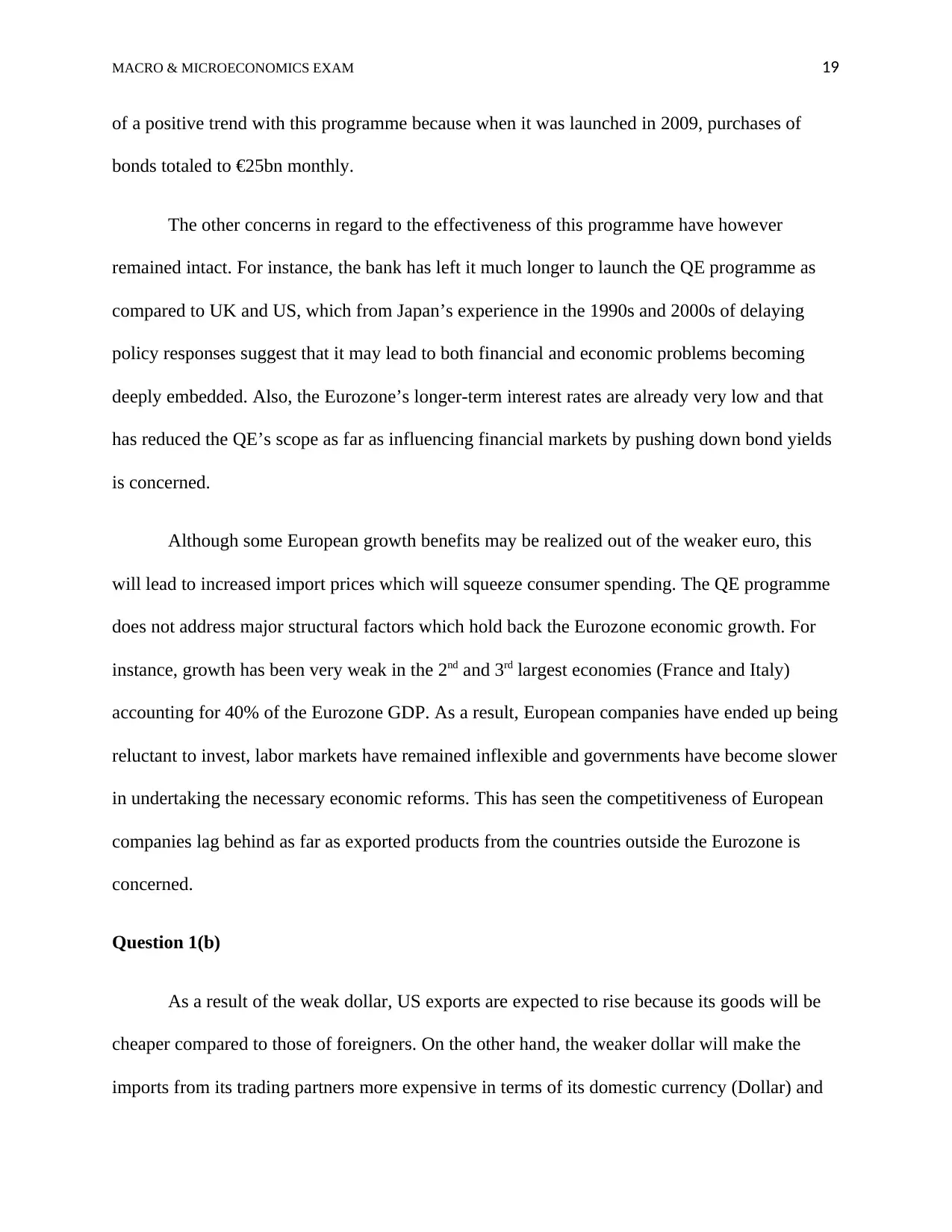
MACRO & MICROECONOMICS EXAM 19
of a positive trend with this programme because when it was launched in 2009, purchases of
bonds totaled to €25bn monthly.
The other concerns in regard to the effectiveness of this programme have however
remained intact. For instance, the bank has left it much longer to launch the QE programme as
compared to UK and US, which from Japan’s experience in the 1990s and 2000s of delaying
policy responses suggest that it may lead to both financial and economic problems becoming
deeply embedded. Also, the Eurozone’s longer-term interest rates are already very low and that
has reduced the QE’s scope as far as influencing financial markets by pushing down bond yields
is concerned.
Although some European growth benefits may be realized out of the weaker euro, this
will lead to increased import prices which will squeeze consumer spending. The QE programme
does not address major structural factors which hold back the Eurozone economic growth. For
instance, growth has been very weak in the 2nd and 3rd largest economies (France and Italy)
accounting for 40% of the Eurozone GDP. As a result, European companies have ended up being
reluctant to invest, labor markets have remained inflexible and governments have become slower
in undertaking the necessary economic reforms. This has seen the competitiveness of European
companies lag behind as far as exported products from the countries outside the Eurozone is
concerned.
Question 1(b)
As a result of the weak dollar, US exports are expected to rise because its goods will be
cheaper compared to those of foreigners. On the other hand, the weaker dollar will make the
imports from its trading partners more expensive in terms of its domestic currency (Dollar) and
of a positive trend with this programme because when it was launched in 2009, purchases of
bonds totaled to €25bn monthly.
The other concerns in regard to the effectiveness of this programme have however
remained intact. For instance, the bank has left it much longer to launch the QE programme as
compared to UK and US, which from Japan’s experience in the 1990s and 2000s of delaying
policy responses suggest that it may lead to both financial and economic problems becoming
deeply embedded. Also, the Eurozone’s longer-term interest rates are already very low and that
has reduced the QE’s scope as far as influencing financial markets by pushing down bond yields
is concerned.
Although some European growth benefits may be realized out of the weaker euro, this
will lead to increased import prices which will squeeze consumer spending. The QE programme
does not address major structural factors which hold back the Eurozone economic growth. For
instance, growth has been very weak in the 2nd and 3rd largest economies (France and Italy)
accounting for 40% of the Eurozone GDP. As a result, European companies have ended up being
reluctant to invest, labor markets have remained inflexible and governments have become slower
in undertaking the necessary economic reforms. This has seen the competitiveness of European
companies lag behind as far as exported products from the countries outside the Eurozone is
concerned.
Question 1(b)
As a result of the weak dollar, US exports are expected to rise because its goods will be
cheaper compared to those of foreigners. On the other hand, the weaker dollar will make the
imports from its trading partners more expensive in terms of its domestic currency (Dollar) and
Paraphrase This Document
Need a fresh take? Get an instant paraphrase of this document with our AI Paraphraser
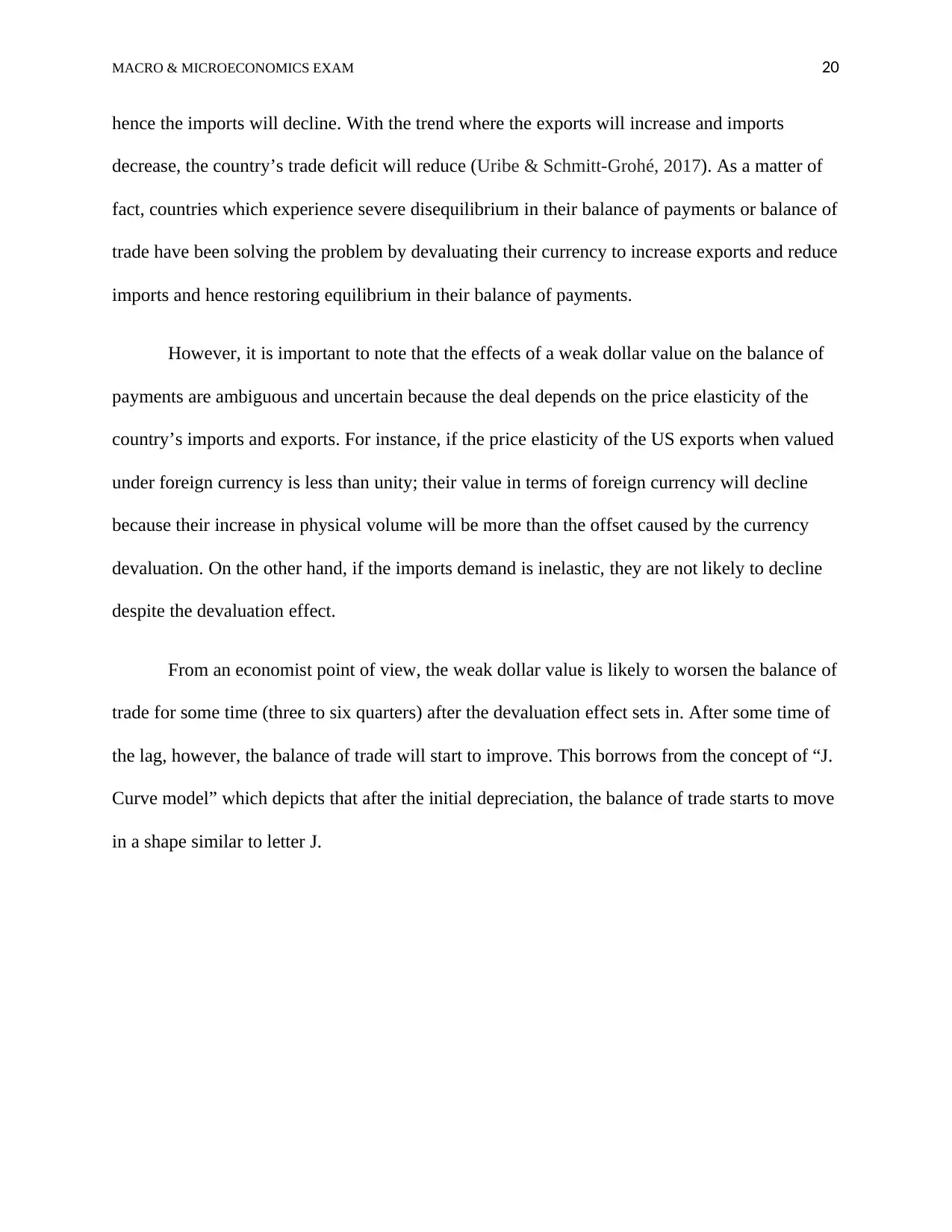
MACRO & MICROECONOMICS EXAM 20
hence the imports will decline. With the trend where the exports will increase and imports
decrease, the country’s trade deficit will reduce (Uribe & Schmitt-Grohé, 2017). As a matter of
fact, countries which experience severe disequilibrium in their balance of payments or balance of
trade have been solving the problem by devaluating their currency to increase exports and reduce
imports and hence restoring equilibrium in their balance of payments.
However, it is important to note that the effects of a weak dollar value on the balance of
payments are ambiguous and uncertain because the deal depends on the price elasticity of the
country’s imports and exports. For instance, if the price elasticity of the US exports when valued
under foreign currency is less than unity; their value in terms of foreign currency will decline
because their increase in physical volume will be more than the offset caused by the currency
devaluation. On the other hand, if the imports demand is inelastic, they are not likely to decline
despite the devaluation effect.
From an economist point of view, the weak dollar value is likely to worsen the balance of
trade for some time (three to six quarters) after the devaluation effect sets in. After some time of
the lag, however, the balance of trade will start to improve. This borrows from the concept of “J.
Curve model” which depicts that after the initial depreciation, the balance of trade starts to move
in a shape similar to letter J.
hence the imports will decline. With the trend where the exports will increase and imports
decrease, the country’s trade deficit will reduce (Uribe & Schmitt-Grohé, 2017). As a matter of
fact, countries which experience severe disequilibrium in their balance of payments or balance of
trade have been solving the problem by devaluating their currency to increase exports and reduce
imports and hence restoring equilibrium in their balance of payments.
However, it is important to note that the effects of a weak dollar value on the balance of
payments are ambiguous and uncertain because the deal depends on the price elasticity of the
country’s imports and exports. For instance, if the price elasticity of the US exports when valued
under foreign currency is less than unity; their value in terms of foreign currency will decline
because their increase in physical volume will be more than the offset caused by the currency
devaluation. On the other hand, if the imports demand is inelastic, they are not likely to decline
despite the devaluation effect.
From an economist point of view, the weak dollar value is likely to worsen the balance of
trade for some time (three to six quarters) after the devaluation effect sets in. After some time of
the lag, however, the balance of trade will start to improve. This borrows from the concept of “J.
Curve model” which depicts that after the initial depreciation, the balance of trade starts to move
in a shape similar to letter J.

MACRO & MICROECONOMICS EXAM 21
This indicates that a few quarters after devaluation starts, the balance of trade will
become worse and after that, it becomes positive and starts improving. This is the J-curve effect
as it has been presented in the above figure, where along the X-axis time is measured and on the
Y-axis balance of trade is measured. If the balance of trade value is positive or simply above zero
and the curve rise, the balance of trade is improving. And if the balance of trade value is negative
and the curve slopes down, the balance of trade is worsening.
Question 2 (50Marks):
From an economist point of view, what Donald Trump together with is administration is
what is viewed as trade protectionism. Trade protectionism is a deliberate attempt by the
government to restrict imports or promote exports by enacting some trade barriers. As a result of
This indicates that a few quarters after devaluation starts, the balance of trade will
become worse and after that, it becomes positive and starts improving. This is the J-curve effect
as it has been presented in the above figure, where along the X-axis time is measured and on the
Y-axis balance of trade is measured. If the balance of trade value is positive or simply above zero
and the curve rise, the balance of trade is improving. And if the balance of trade value is negative
and the curve slopes down, the balance of trade is worsening.
Question 2 (50Marks):
From an economist point of view, what Donald Trump together with is administration is
what is viewed as trade protectionism. Trade protectionism is a deliberate attempt by the
government to restrict imports or promote exports by enacting some trade barriers. As a result of

MACRO & MICROECONOMICS EXAM 22
Trump’s decision to engage in trade protectionism, both the consumers and business people will
be affected in the following ways
The country will have inefficient resource allocation in the long run
Following the imposition of import tariffs, the end results will be a loss in allocative
efficiency. This is because of the fact that protected producers don’t face the international
competition and will lag behind as far as innovativeness is concerned. In the long run, local
producers in America will become less competitive hence falling behind the rest of the world
producers. In addition, the imposed tariffs will increase domestic market prices and distort the
signals which direct investment towards the inefficient industries.
The country will experience downward multiplier effects
As a result of Trump’s decision to protect the local producers, the exports from their
trading partners as well as their aggregate demand and national output will be reduced. As a
result, they will also import less from the US considering the fact that imports are functioned to
national income level. This will shortly result in a decline in the country’s local production and
which also implies a decline in income.
Trading partners may decide to retaliate
The protectionism may be perceived as a spark of enmity by the US towards her trading
partners and decides to retaliate. This will, therefore, imply that the country’s exports will as well
be restricted from entering the trading partners and this will affect local producers and business
which operate on the import-export basis.
The US will suffer the loss of allocative efficiency in the short run
Trump’s decision to engage in trade protectionism, both the consumers and business people will
be affected in the following ways
The country will have inefficient resource allocation in the long run
Following the imposition of import tariffs, the end results will be a loss in allocative
efficiency. This is because of the fact that protected producers don’t face the international
competition and will lag behind as far as innovativeness is concerned. In the long run, local
producers in America will become less competitive hence falling behind the rest of the world
producers. In addition, the imposed tariffs will increase domestic market prices and distort the
signals which direct investment towards the inefficient industries.
The country will experience downward multiplier effects
As a result of Trump’s decision to protect the local producers, the exports from their
trading partners as well as their aggregate demand and national output will be reduced. As a
result, they will also import less from the US considering the fact that imports are functioned to
national income level. This will shortly result in a decline in the country’s local production and
which also implies a decline in income.
Trading partners may decide to retaliate
The protectionism may be perceived as a spark of enmity by the US towards her trading
partners and decides to retaliate. This will, therefore, imply that the country’s exports will as well
be restricted from entering the trading partners and this will affect local producers and business
which operate on the import-export basis.
The US will suffer the loss of allocative efficiency in the short run
Secure Best Marks with AI Grader
Need help grading? Try our AI Grader for instant feedback on your assignments.
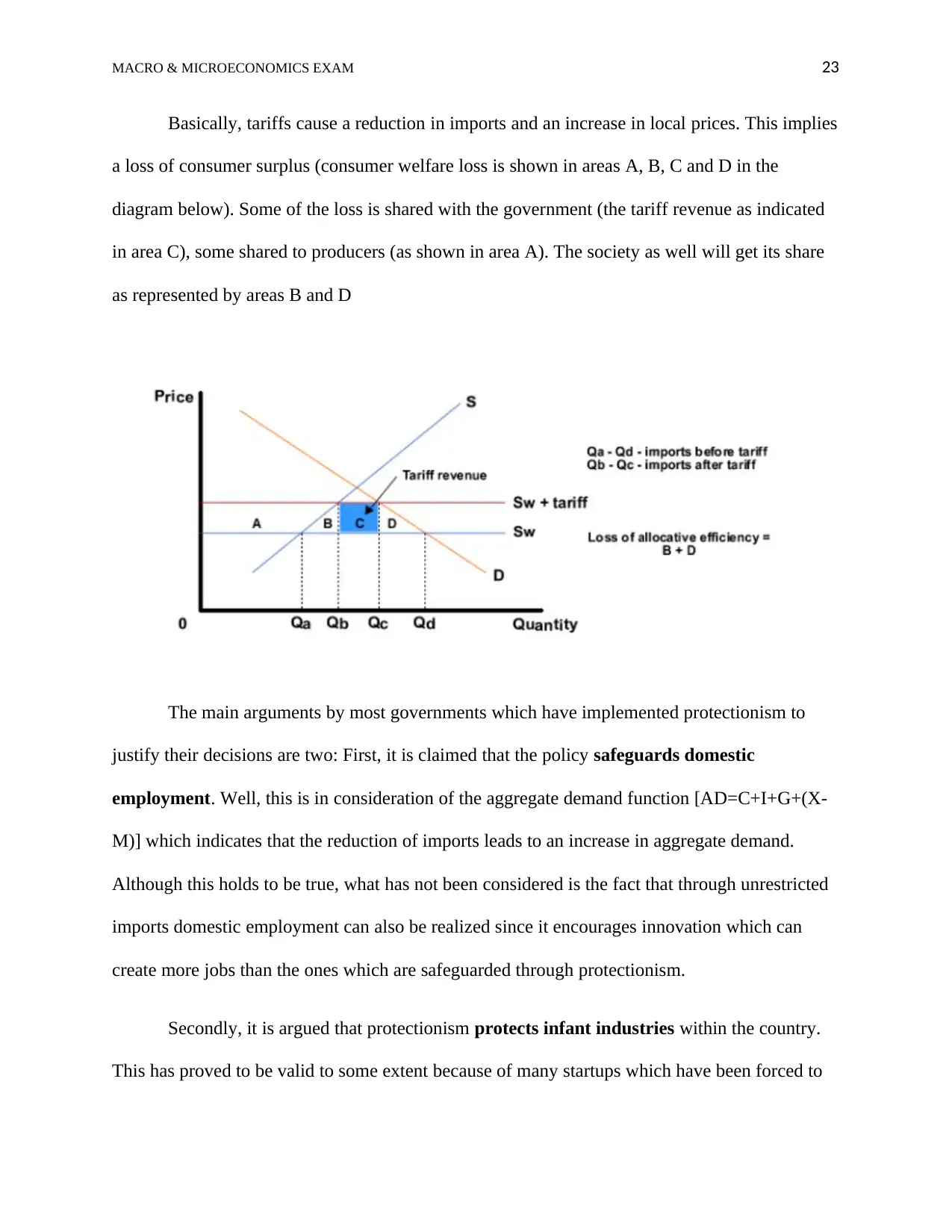
MACRO & MICROECONOMICS EXAM 23
Basically, tariffs cause a reduction in imports and an increase in local prices. This implies
a loss of consumer surplus (consumer welfare loss is shown in areas A, B, C and D in the
diagram below). Some of the loss is shared with the government (the tariff revenue as indicated
in area C), some shared to producers (as shown in area A). The society as well will get its share
as represented by areas B and D
The main arguments by most governments which have implemented protectionism to
justify their decisions are two: First, it is claimed that the policy safeguards domestic
employment. Well, this is in consideration of the aggregate demand function [AD=C+I+G+(X-
M)] which indicates that the reduction of imports leads to an increase in aggregate demand.
Although this holds to be true, what has not been considered is the fact that through unrestricted
imports domestic employment can also be realized since it encourages innovation which can
create more jobs than the ones which are safeguarded through protectionism.
Secondly, it is argued that protectionism protects infant industries within the country.
This has proved to be valid to some extent because of many startups which have been forced to
Basically, tariffs cause a reduction in imports and an increase in local prices. This implies
a loss of consumer surplus (consumer welfare loss is shown in areas A, B, C and D in the
diagram below). Some of the loss is shared with the government (the tariff revenue as indicated
in area C), some shared to producers (as shown in area A). The society as well will get its share
as represented by areas B and D
The main arguments by most governments which have implemented protectionism to
justify their decisions are two: First, it is claimed that the policy safeguards domestic
employment. Well, this is in consideration of the aggregate demand function [AD=C+I+G+(X-
M)] which indicates that the reduction of imports leads to an increase in aggregate demand.
Although this holds to be true, what has not been considered is the fact that through unrestricted
imports domestic employment can also be realized since it encourages innovation which can
create more jobs than the ones which are safeguarded through protectionism.
Secondly, it is argued that protectionism protects infant industries within the country.
This has proved to be valid to some extent because of many startups which have been forced to
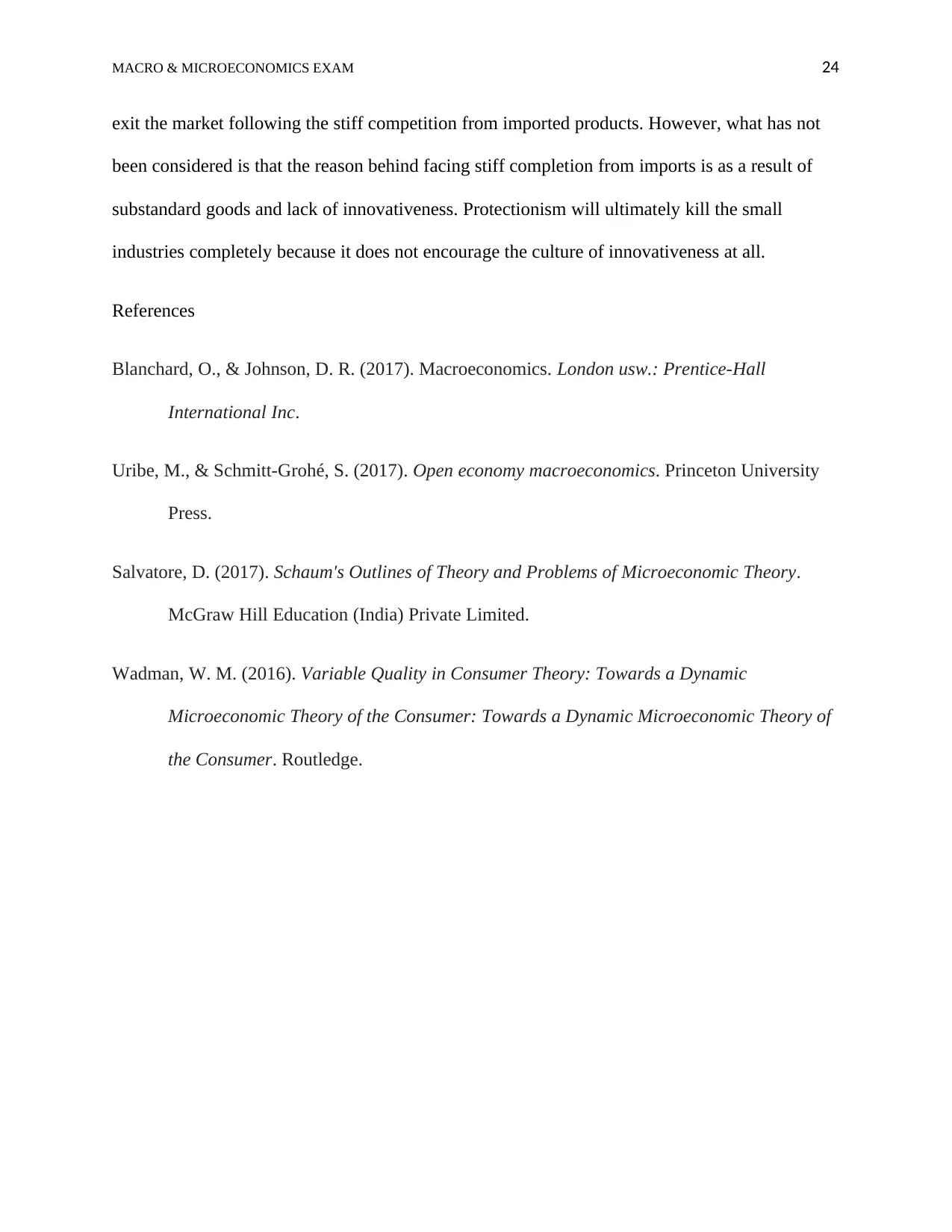
MACRO & MICROECONOMICS EXAM 24
exit the market following the stiff competition from imported products. However, what has not
been considered is that the reason behind facing stiff completion from imports is as a result of
substandard goods and lack of innovativeness. Protectionism will ultimately kill the small
industries completely because it does not encourage the culture of innovativeness at all.
References
Blanchard, O., & Johnson, D. R. (2017). Macroeconomics. London usw.: Prentice-Hall
International Inc.
Uribe, M., & Schmitt-Grohé, S. (2017). Open economy macroeconomics. Princeton University
Press.
Salvatore, D. (2017). Schaum's Outlines of Theory and Problems of Microeconomic Theory.
McGraw Hill Education (India) Private Limited.
Wadman, W. M. (2016). Variable Quality in Consumer Theory: Towards a Dynamic
Microeconomic Theory of the Consumer: Towards a Dynamic Microeconomic Theory of
the Consumer. Routledge.
exit the market following the stiff competition from imported products. However, what has not
been considered is that the reason behind facing stiff completion from imports is as a result of
substandard goods and lack of innovativeness. Protectionism will ultimately kill the small
industries completely because it does not encourage the culture of innovativeness at all.
References
Blanchard, O., & Johnson, D. R. (2017). Macroeconomics. London usw.: Prentice-Hall
International Inc.
Uribe, M., & Schmitt-Grohé, S. (2017). Open economy macroeconomics. Princeton University
Press.
Salvatore, D. (2017). Schaum's Outlines of Theory and Problems of Microeconomic Theory.
McGraw Hill Education (India) Private Limited.
Wadman, W. M. (2016). Variable Quality in Consumer Theory: Towards a Dynamic
Microeconomic Theory of the Consumer: Towards a Dynamic Microeconomic Theory of
the Consumer. Routledge.
1 out of 24
Related Documents
Your All-in-One AI-Powered Toolkit for Academic Success.
+13062052269
info@desklib.com
Available 24*7 on WhatsApp / Email
![[object Object]](/_next/static/media/star-bottom.7253800d.svg)
Unlock your academic potential
© 2024 | Zucol Services PVT LTD | All rights reserved.





